Pivot Firebird V5
Wheel Sizes:
- Size XS: 29’’ front / 27.5’’ rear
- Sizes S–XL: 29’’ front / 29’’ or 27.5’’ rear (convertible)
Suspension Travel:
- Frame: 165 mm
- Fork: 170 mm
Geometry Highlights:
- Sizes offered: XS, S, M, L, XL
- Headtube angle: 63.8° (29’’, low; varies by wheel size & flip chip setting)
- Reach (size Medium): 468 mm (29’’, low; varies by wheel size & flip chip setting)
- Chainstay length (size Medium): 433 mm / 441 mm (adjustable)
Frame Material: Carbon fiber
Price: Complete bikes $6,899 to $15,099
Blister’s Measured Weight: 34.86 lb / 15.81 kg (Firebird Pro XT Di2, size Large)
Test Locations: Washington & British Columbia
Reviewer: 6’, 160 lbs / 183 cm, 72.6 kg
Test Duration: 3 months
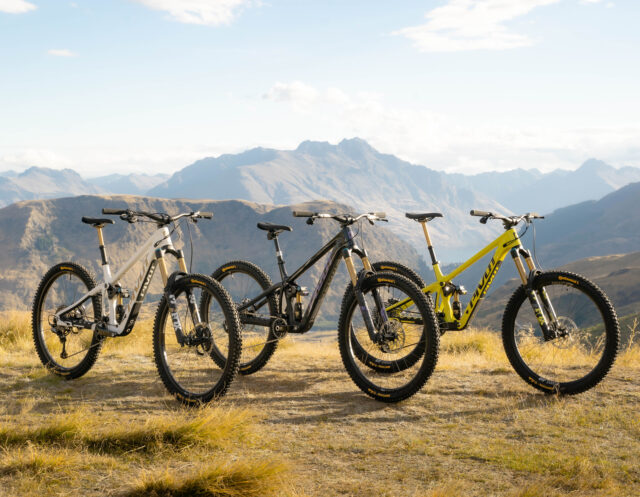
Intro
The fourth-generation Pivot Firebird was a big departure from the original Firebird 29 that it replaced (the first two Firebirds were 27.5’’-wheeled bikes) in terms of its geometry, suspension layout, and overall performance. I got along quite well with the most recent Firebird when I reviewed it a few years back and found it to offer an interesting combination of good stability and composure at speed while being just a bit more nimble and quick-handling than a lot of bikes in its class. For the right folks, what combination of traits was rather compelling.
But now there’s a new Firebird, and while it looks a lot like the version it’s replacing, the Firebird V5 gets some meaningful geometry tweaks, a lot more adjustability, and some new features. Let’s check it out.
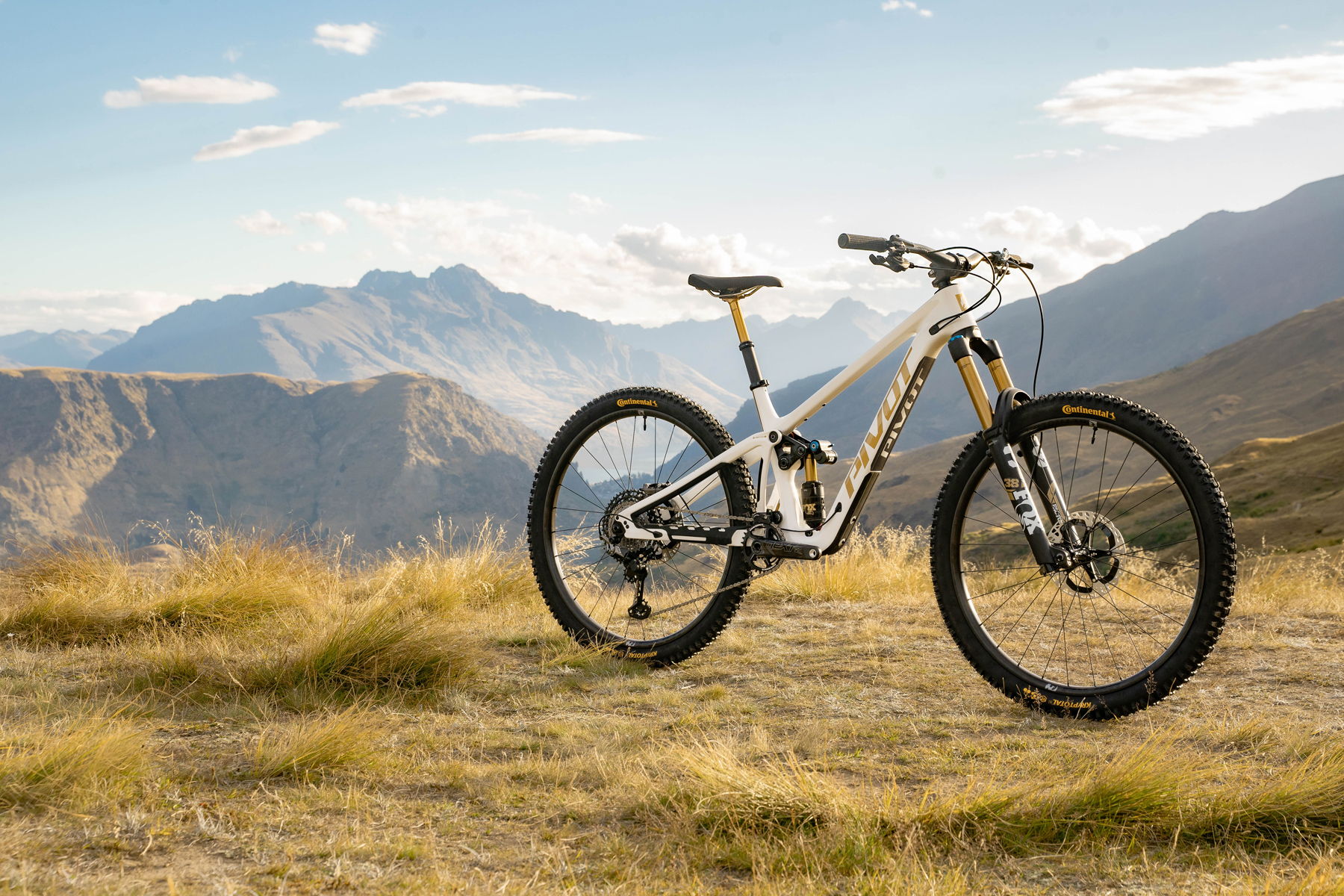
The Frame
Most of the top-level details haven’t changed much on the new bike. It still delivers 165 mm of rear travel via Pivot’s typical DW-Link suspension layout, and it keeps the same basic layout as the prior-gen bike with a vertically oriented shock. It’s still based around a 170mm-travel fork (Pivot says you can run up to a 180 mm one), and it’s also still compatible with full 29’’ wheel or mixed wheel size configurations (apart from the XS frame, which is MX only). The straight 56 mm headtube carries over, too, to offer easier compatibility with reach / angle-adjust headsets. The Super Boost 157 mm rear wheel spacing that Pivot favors on their non-XC MTBs carries over here, too. And as with all of Pivot’s current bikes and the outgoing Firebird, the new Firebird frame is offered in carbon fiber only, with different layups across the size range to tailor the frame stiffness for typical rider weights on a given frame size.
But there are a bunch of new features and updates. For starters, the Firebird now features Pivot’s Toolshed downtube storage to go with the Tool Dock system (a pair of mounting bolts under the top tube, with a variety of options for mounting various Topeak tools and other accessories), which has been around for a while now.
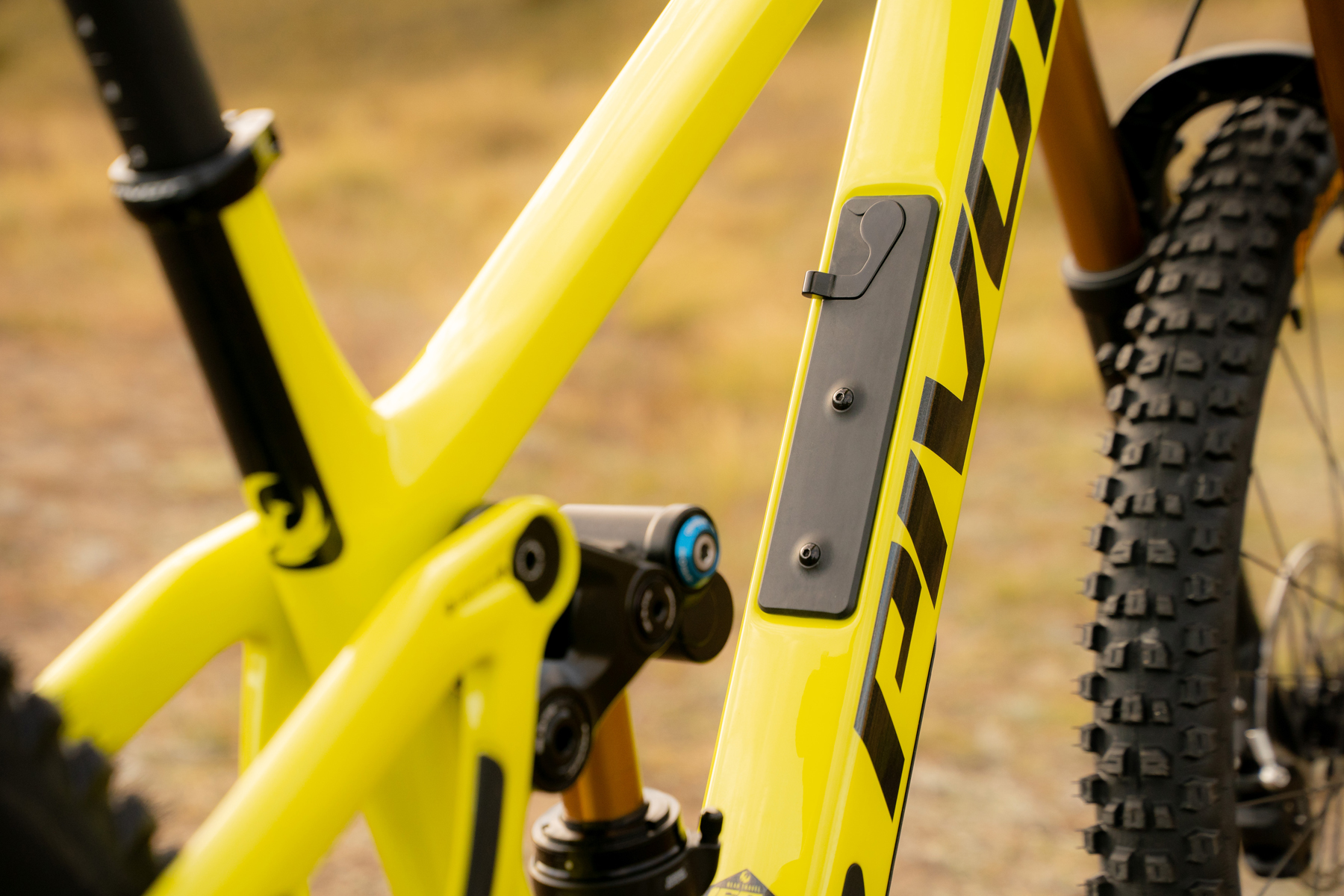
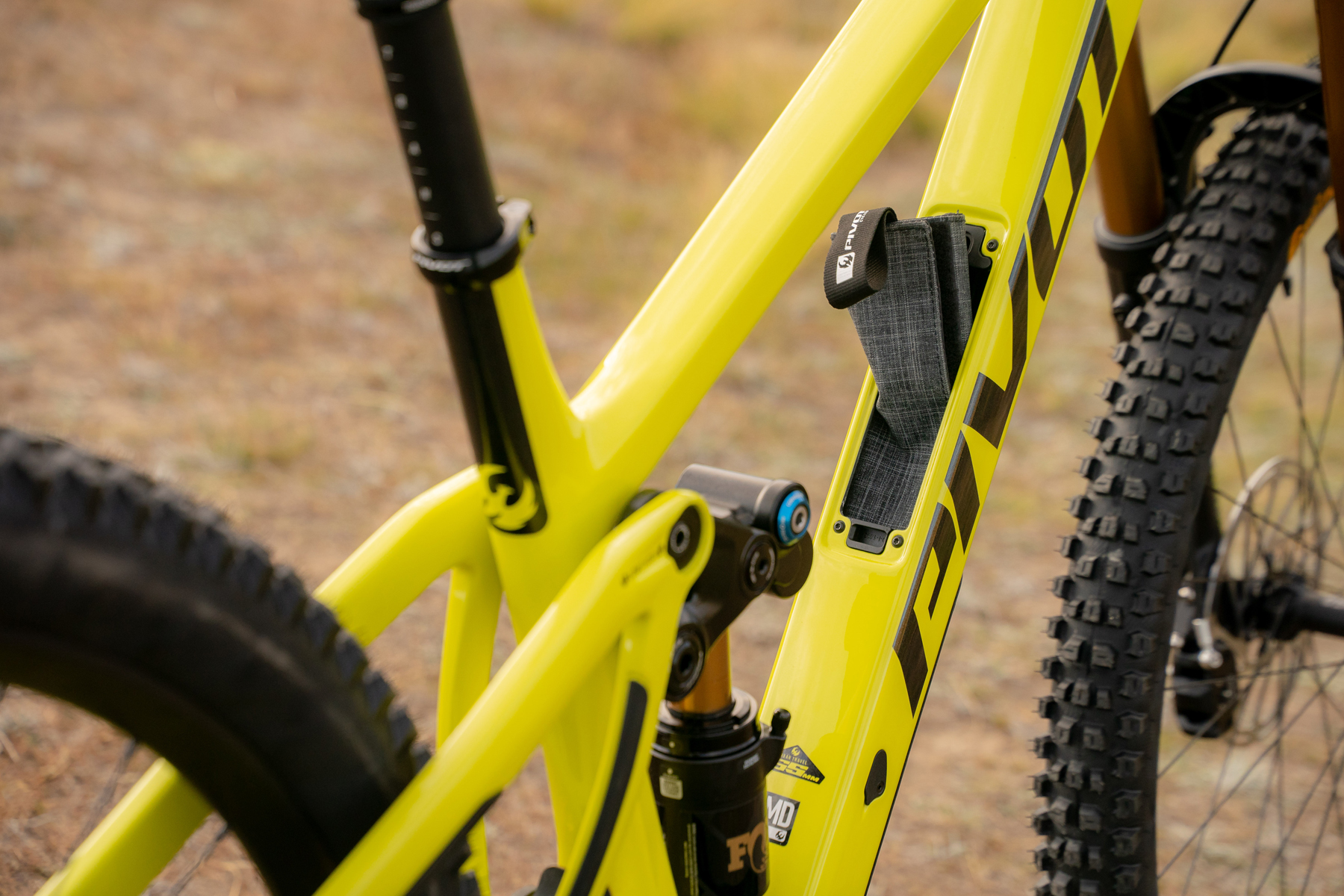
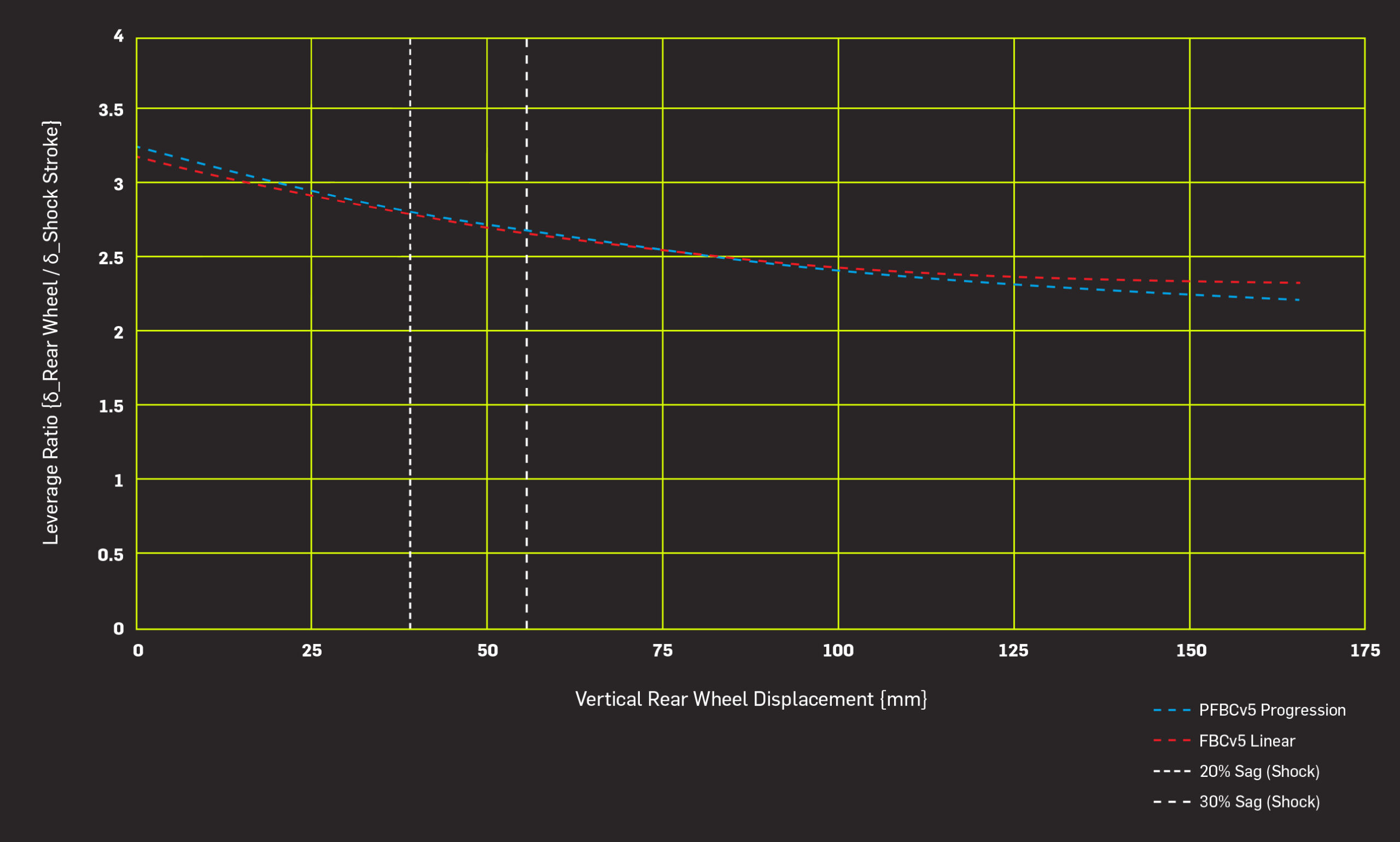
The Firebird, unsurprisingly, features a UDH derailleur hanger for SRAM Transmission compatibility, but the UDH standard poses one notable challenge for frame designers: it’s tough to package a UDH and chainstay length adjustability. RAAW, for example, offers the choice of a UDH or chainstay length adjustability on the Madonna, but you can’t have both. A few other manufacturers have managed to combine the two (e.g., Nicolai with the new G1), but those solutions tend to be more complicated than just a standard flip chip.
Pivot has come up with a tidy way to have their cake and eat it, too. The Firebird’s non-driveside dropout uses a standard-looking flip chip to toggle between two different chainstay length settings, but the drive side one instead uses a swinging design to match the flip chip. The drive side dropout attaches to the frame with three bolts; the upper one acts as the pivot point, while the other two lock the dropout into one of the two positions. An insert is included to slot into the space between the dropout and the swingarm in the long chainstay setting to better distribute forces from the dropout into the swingarm rather than relying on the bolts alone. We’ll cover the resulting geometry changes in more detail below, but the Swinger Dropout offers 8 mm of chainstay length adjustment between the two settings; the rear brake mount is reversible to maintain alignment with the rotor across both settings.
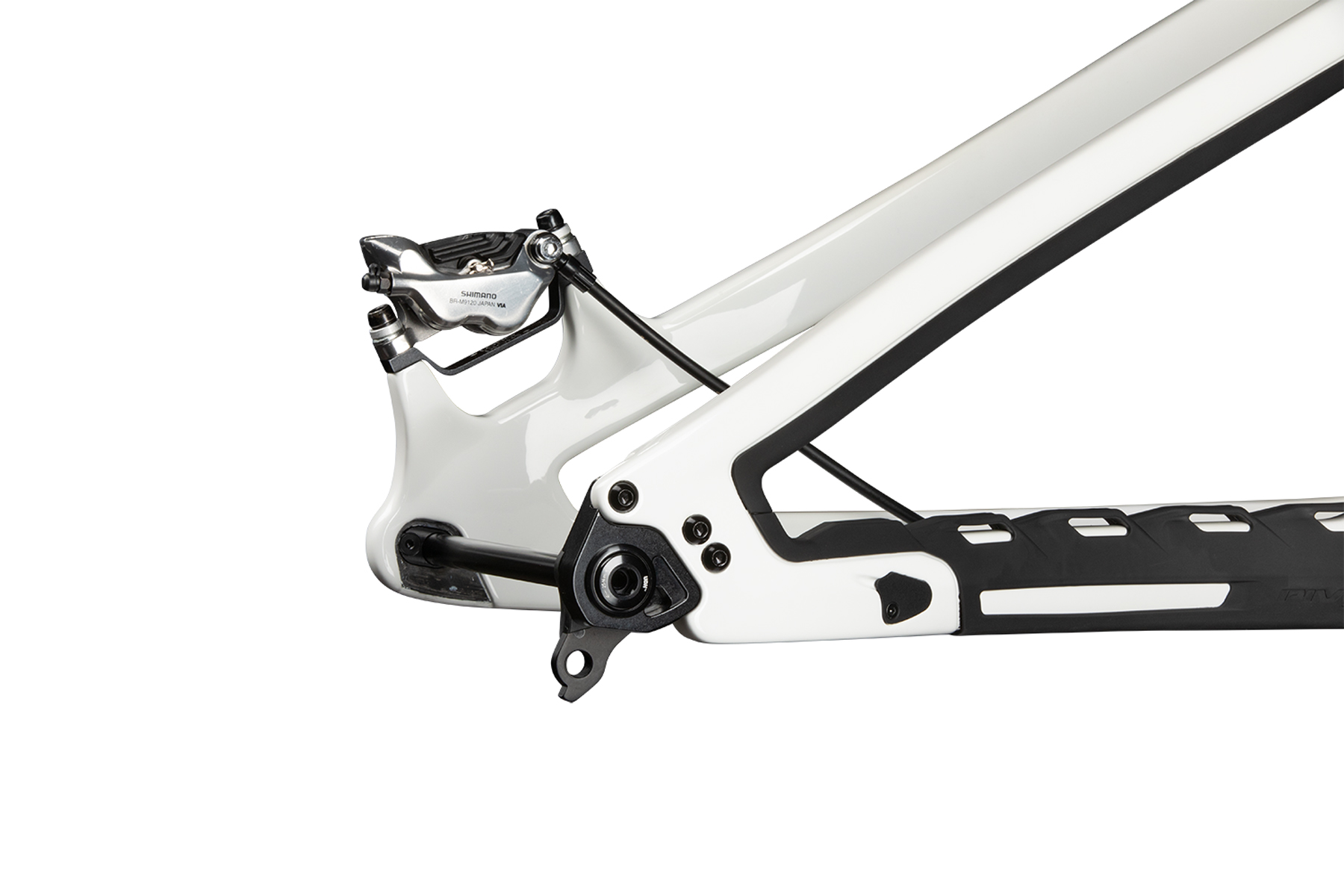
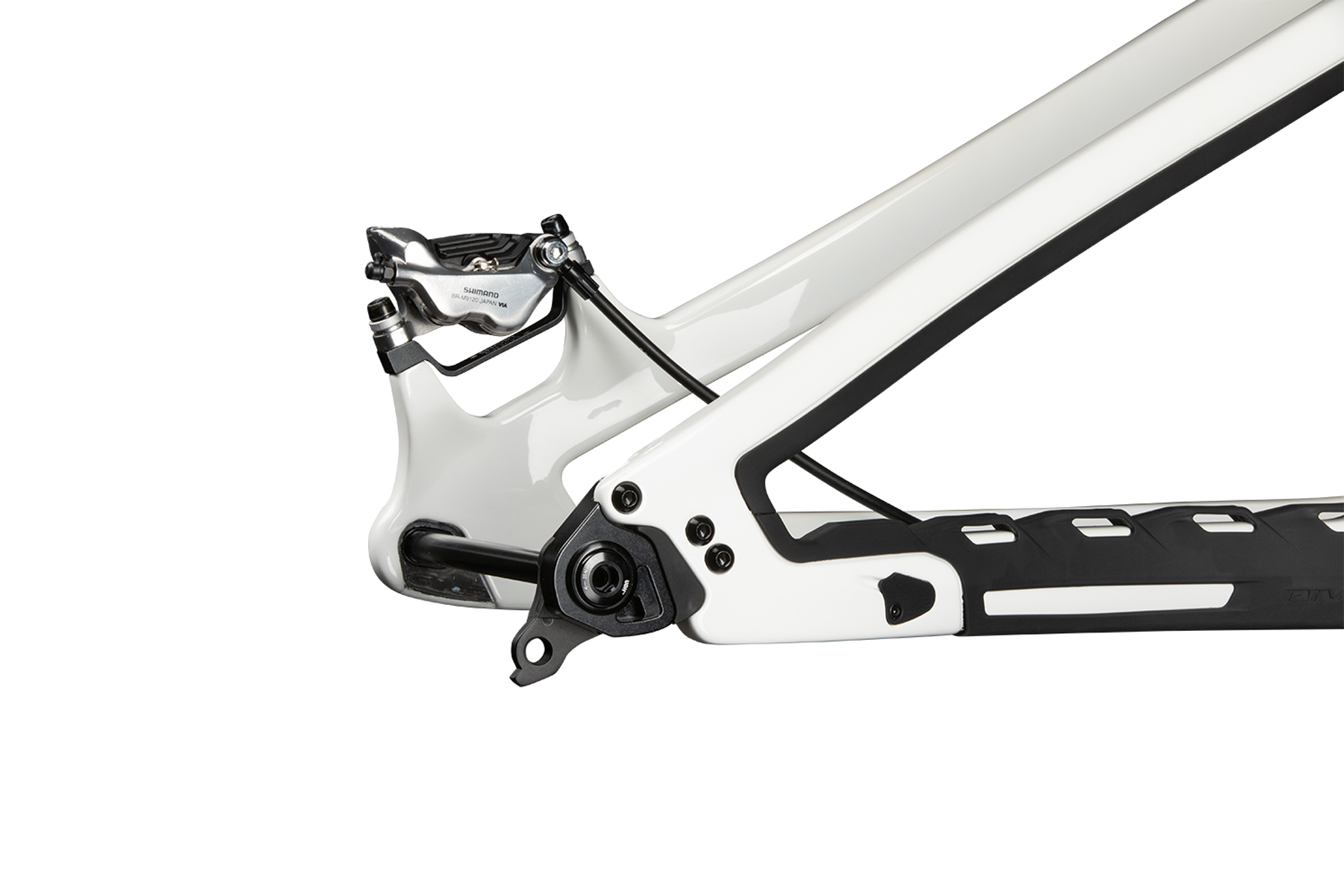
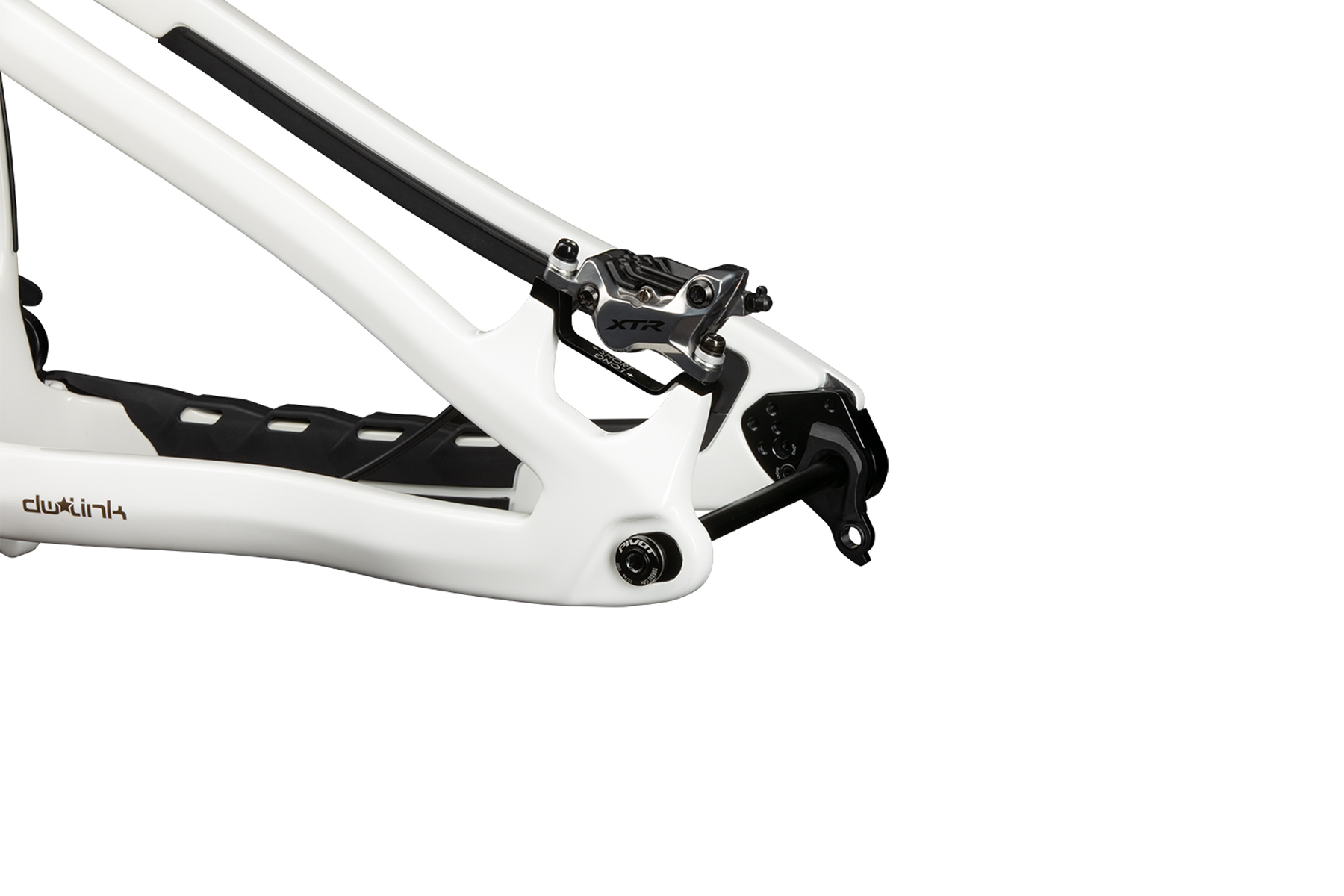
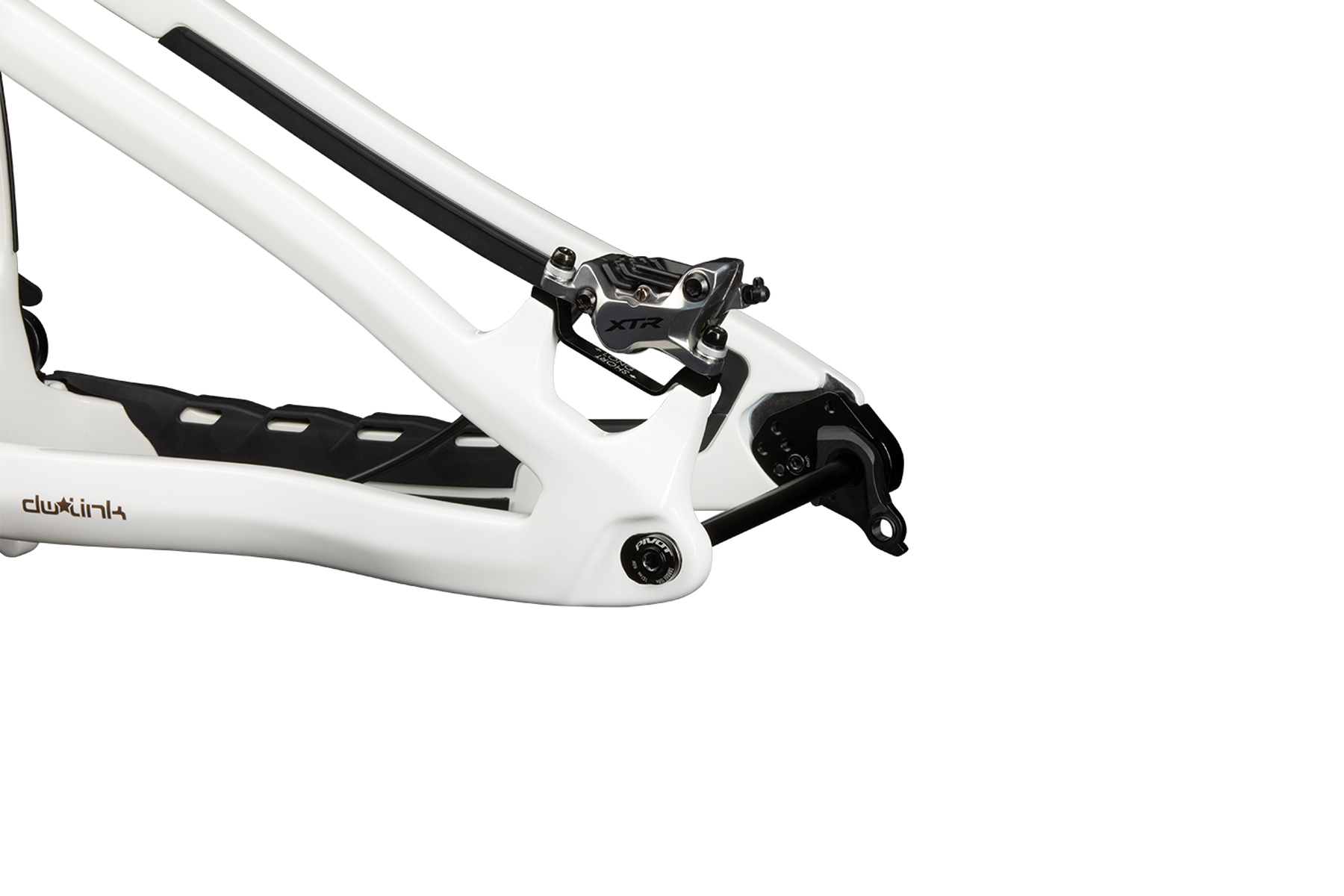
Fit & Geometry
Pivot has made some notable updates to the Firebird’s geometry — including adding a new XS size — but the larger sizes see some changes, too. The head tube angle has been relaxed very slightly to 63.8°, the seat tube steepened a degree to 77°, and the bottom bracket lowered by 5 mm, though at 25 mm drop, it’s still not all that low compared to a number of other Enduro bikes that are closer to 35 mm of drop. The stack height has been increased by about 5 mm across the board; reach figures remain very similar to the outgoing bike, with the biggest change being that the XL has shrunk by 5 mm, to 505 mm.
All those figures are with 29’’ wheels, in the low flip chip setting. Switching to the high setting steepens the head tube by 0.4° and the seat tube by 0.75°, raises the bottom bracket by 8 mm, and makes slight tweaks to the reach and stack figures as well.
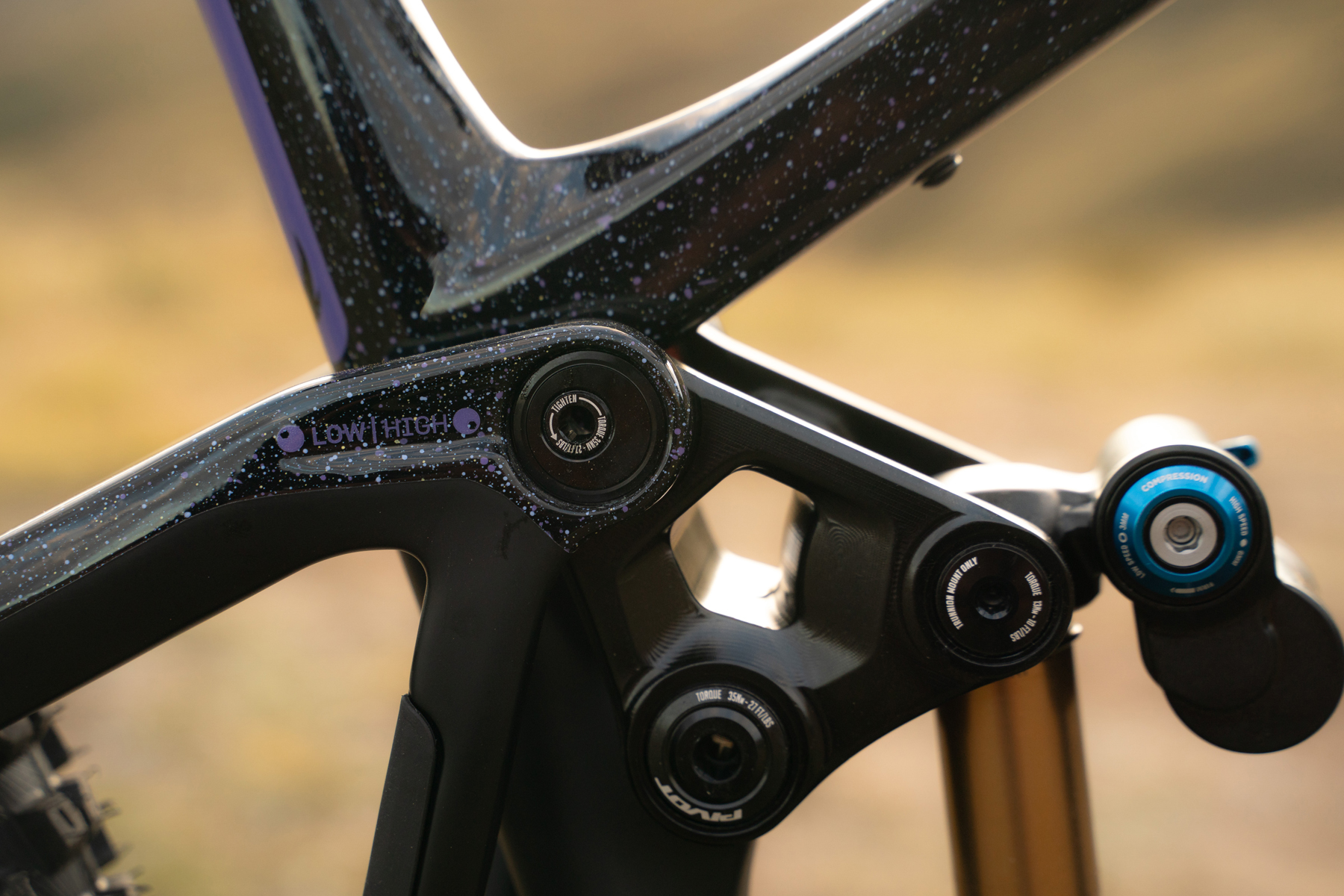
The prior-gen Firebird was Pivot’s first bike to feature size-specific chainstay lengths, which have since propagated to much of their lineup. That continues with the new Firebird, but the addition of the chainstay length adjustment gives an additional option there. The short chainstay setting produces about the same chainstay lengths as the outgoing bike on the Small and Medium frames but is a few millimeters shorter on the Large (435 mm vs. 438 mm on the prior-gen version); the XL frame’s short setting is much shorter than the outgoing bike, now 437 mm versus the old one’s 445 mm. As mentioned above, swapping to the long setting lengthens the chainstays by an additional 8 mm.
The Firebird’s mixed wheel configuration doesn’t get its own dedicated adjustment, so going that route lowers and slackens the bike appreciably. Pivot recommends running the bike in the high setting with mixed wheels for that reason, but they publish a geometry chart for mixed wheels in the low one as well. In high, the head tube angle is 63.4°, the effective seat tube angle is listed at 77° (77.6° on the XS), and the bottom bracket is about 5 mm lower than in the 29’’ / low setting (apart from the XS, which is 3 mm higher than the rest of the size range).
The full geometry charts for all four configurations are shown below:
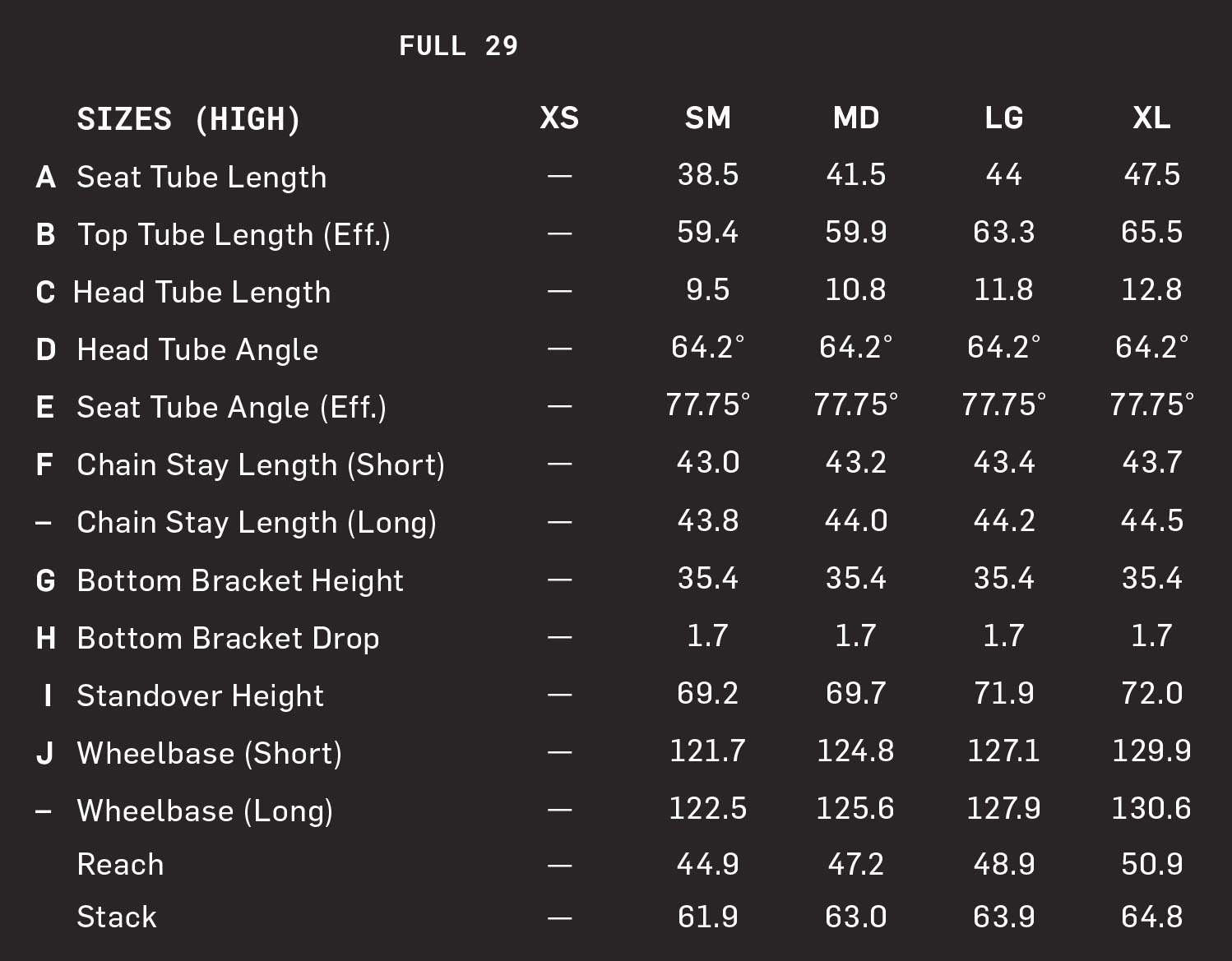
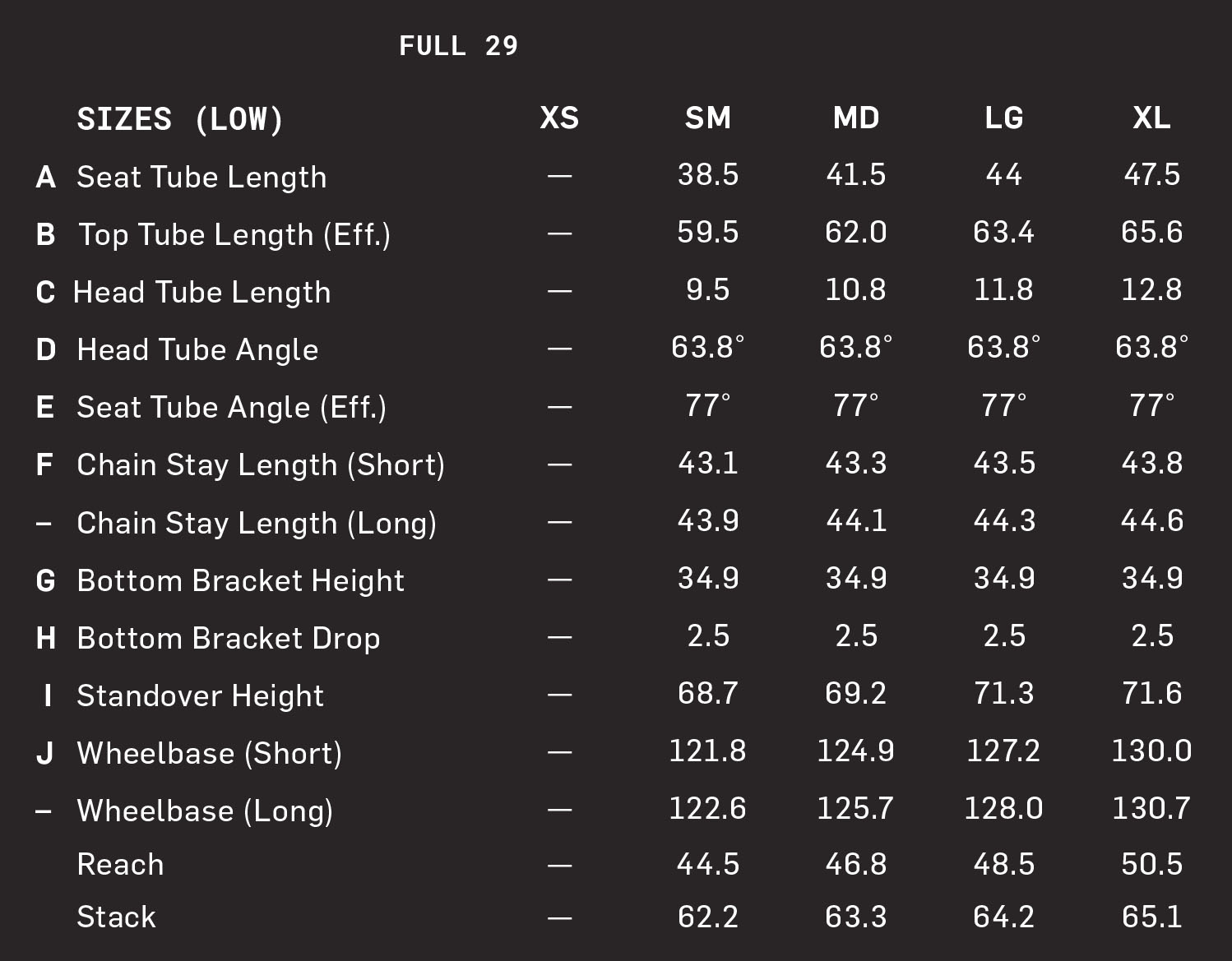
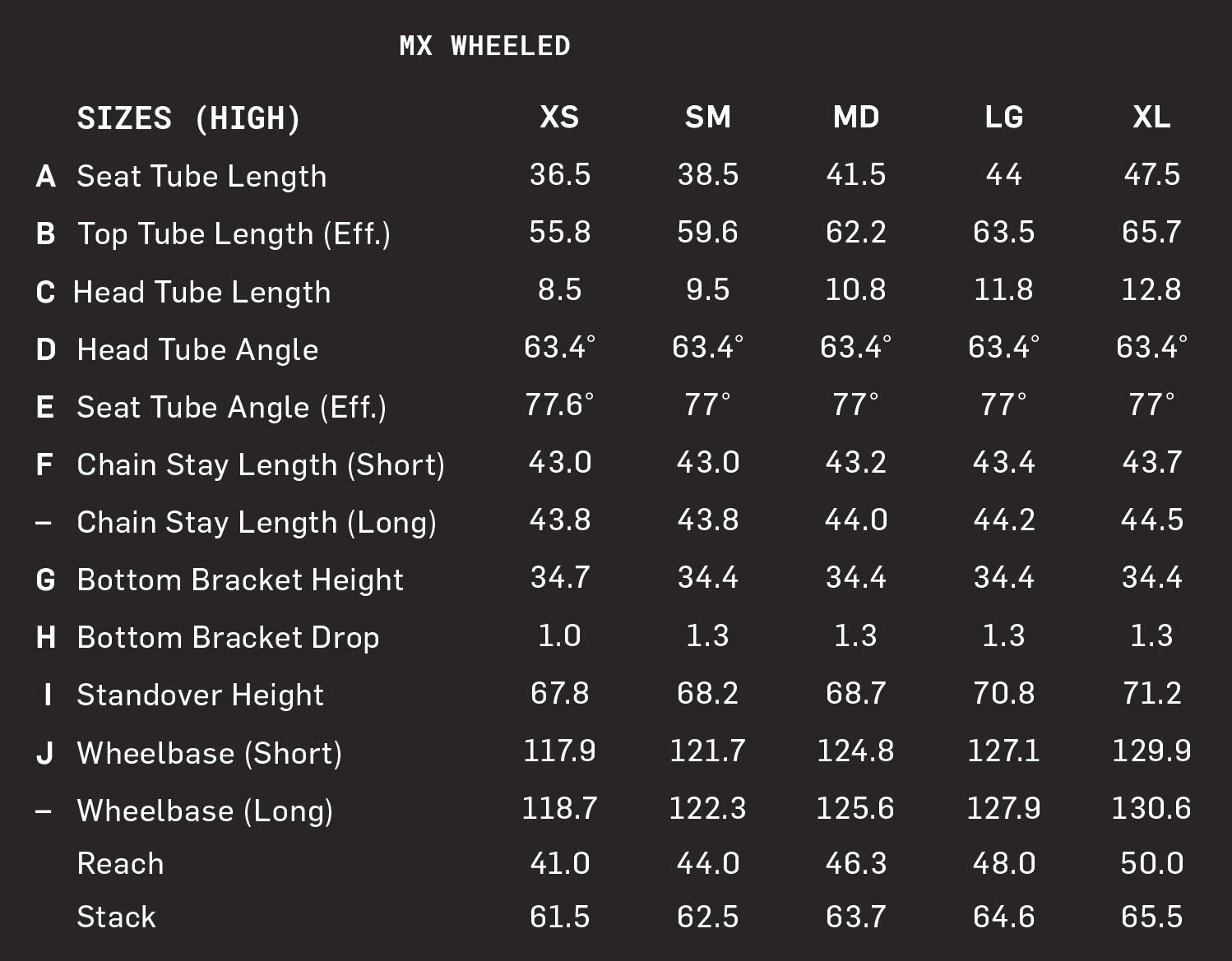
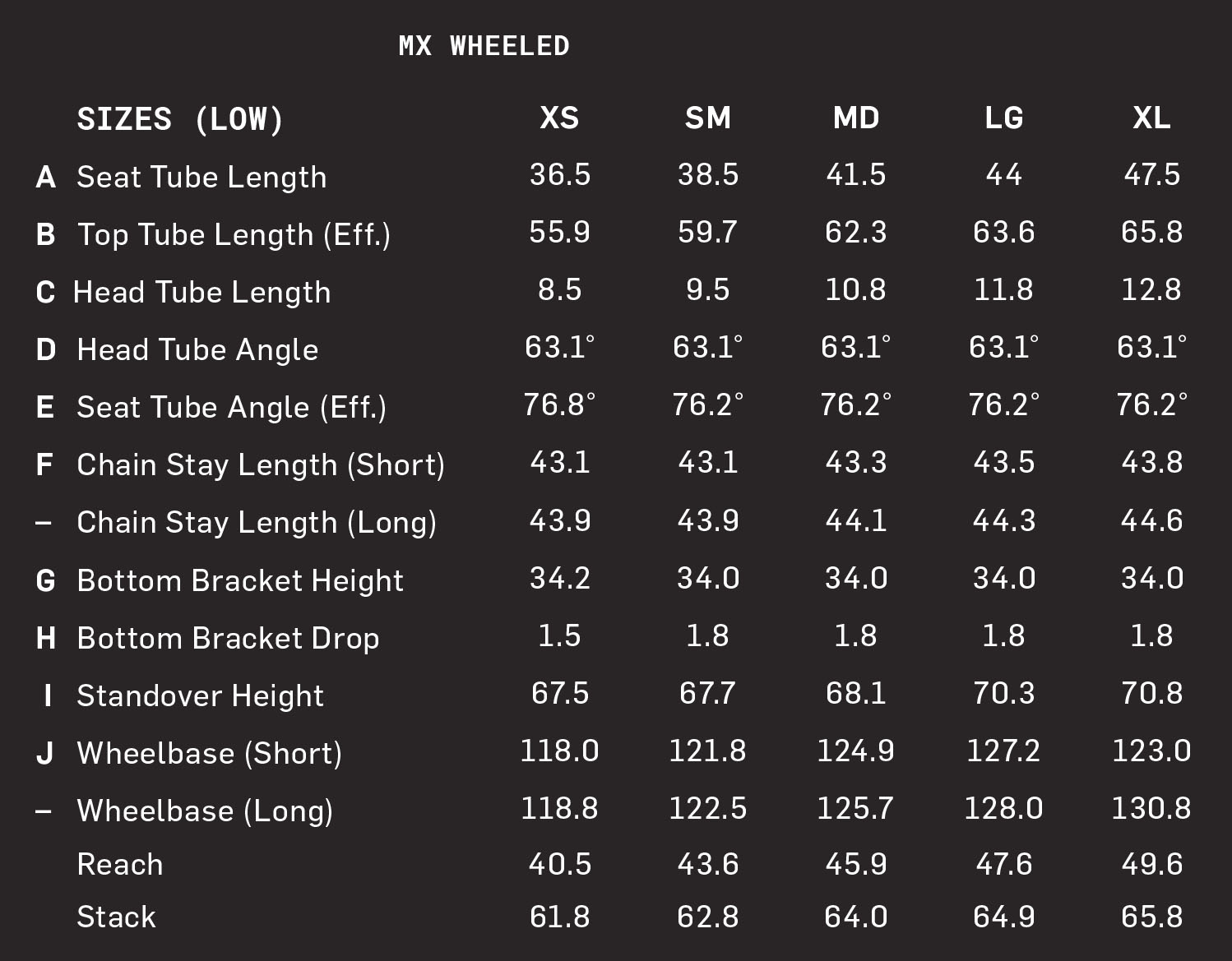
The Builds
Pivot has historically offered a high number of different build options on many of their bikes, and that’s true of the new Firebird as well. As per usual for Pivot, there aren’t any budget offerings here, with the base Ride Eagle 70/90 build starting at $6,899. There are options for both SRAM and Shimano drivetrains and brakes, but Fox handles suspension duties across the whole range.
All the builds are available with your choice of 29’’ or mixed wheels, apart from XS bikes, which are mixed wheel compatible only.
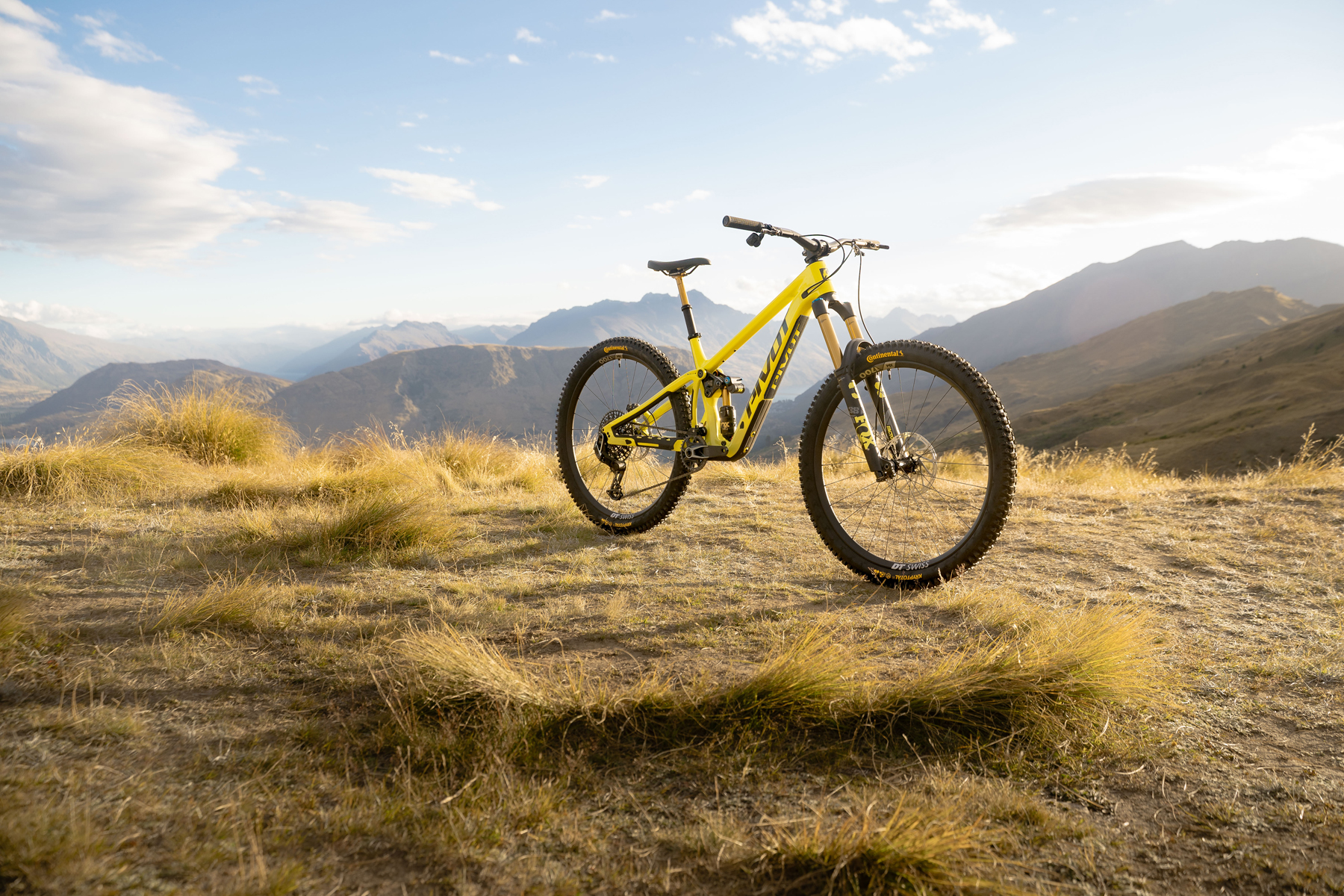
- Drivetrain: SRAM Eagle 70 Transmission w/ Eagle 90 Transmission shifter and derailleur
- Cranks: SRAM Eagle 70
- Brakes: SRAM DB8 w/ 200 mm rotors
- Fork: Fox 38 Performance (170 mm)
- Shock: Fox Float X2 Factory (MY25 version)
- Wheels: DT Swiss M1900
- Dropper post: TransX
- Drivetrain: SRAM GX T-Type
- Cranks: SRAM GX T-Type
- Brakes: SRAM Maven Base w/ 200 mm Centerline rotors
- Fork: Fox 38 Performance (170 mm)
- Shock: Fox Float X2 Factory (MY25 version)
- Wheels: DT Swiss M1900
- Dropper post: SDG Tellis (XS: 130–150 mm; S: 150–170 mm; M & L: 180–200 mm; XL: 210–230 mm)
- Drivetrain: Shimano XT Di2
- Cranks: RaceFace Aeffect R
- Brakes: Shimano XT M8220 4-piston w/ 203 mm rotors
- Fork: Fox 38 Factory Grip X2 (170 mm)
- Shock: Fox Float X2 Factory (MY26 version)
- Wheels: DT Swiss XM1700
- Reynolds Blacklabel Enduro Pro (+$1,400)
- Dropper post: Fox Transfer Factory (XS: 125–150 mm; S: 155–180 mm; M & L: 185–210 mm; XL: 215–240 mm)
- Drivetrain: SRAM X0 T-Type
- Cranks: SRAM X0 T-Type
- Brakes: SRAM Maven Silver w/ 200 mm HS2 rotors
- Fork: Fox 38 Factory Grip X2 (170 mm)
- Shock: Fox Float X2 Factory (MY26 version)
- Wheels: DT Swiss XM1700
- Reynolds Blacklabel Enduro Pro (+$1,400)
- Dropper post: Fox Transfer Factory (XS: 125–150 mm; S: 155–180 mm; M & L: 185–210 mm; XL: 215–240 mm)
- Drivetrain: Shimano XT Di2
- Cranks: RaceFace Aeffect R
- Brakes: Shimano XT M8220 4-piston w/ 203 mm rotors
- Fork: Fox 38 Factory Grip X2 (170 mm)
- Shock: Fox DHX Factory Live Valve Neo
- Wheels: DT Swiss XM1700
- Reynolds Blacklabel Enduro Pro (+$1,400)
- Dropper post: Fox Transfer Neo Factory
- Drivetrain: SRAM X0 T-Type
- Cranks: SRAM X0 T-Type
- Brakes: SRAM Maven Silver w/ 200 mm HS2 rotors
- Fork: Fox 38 Factory Grip X2 (170 mm)
- Shock: Fox DHX Factory Live Valve Neo
- Wheels: DT Swiss XM1700
- Reynolds Blacklabel Enduro Pro (+$1,400)
- Dropper post: RockShox Reverb AXS
- Drivetrain: SRAM XX T-Type
- Cranks: SRAM XX T-Type
- Brakes: SRAM Maven Ultimate w/ 200 mm HS2 rotors
- Fork: Fox Podium Factory (170 mm)
- Shock: Fox Float X2 Factory (MY26 version)
- Wheels: Reynolds Blacklabel Enduro Pro
- Dropper post: RockShox Reverb AXS
- Drivetrain: Shimano XTR Di2
- Cranks: RaceFace Era
- Brakes: Shimano XTR M9220 4-piston w/ 203 mm rotors
- Fork: Fox Podium Factory (170 mm)
- Shock: Fox Float X2 Factory (MY26 version)
- Wheels: Reynolds Blacklabel Enduro Pro
- Dropper post: Fox Transfer Neo Factory
- Drivetrain: SRAM XX T-Type
- Cranks: SRAM XX T-Type
- Brakes: SRAM Maven Ultimate w/ 200 mm HS2 rotors
- Fork: Fox Podium Factory (170 mm)
- Shock: Fox DHX Live Valve Neo
- Wheels: Reynolds Blacklabel Enduro Pro
- Dropper post: RockShox Reverb AXS
- Drivetrain: Shimano XTR Di2
- Cranks: RaceFace Era
- Brakes: Shimano XTR M9220 4-piston w/ 203 mm rotors
- Fork: Fox Podium Factory (170 mm)
- Shock: Fox DHX Live Valve Neo
- Wheels: Reynolds Blacklabel Enduro Pro
- Dropper post: Fox Transfer Neo Factory
FULL REVIEW
The latest iteration of the Pivot Firebird doesn’t look like a huge departure from the prior one on paper, but it’s got tweaked geometry, a bunch more adjustability, and some other new features, including the addition of downtube storage.
So, does the Firebird V5 simply pick up where its predecessor left off, or have the updates added up to make it feel like something entirely different? Here’s what we’ve found out:
Fit & Sizing
David Golay (6’, 160 lb / 183 cm, 72.6 kg): Pivot’s recommended sizing for the Firebird puts me at the very top of the range for the Medium frame and slightly deeper into the sizing band for the Large. I opted for the latter, both because its geometry figures line up more closely with my typical preferences for this sort of bike, and because I’d gotten along quite well with the fit of the prior-generation Firebird in a size Large (which features fairly similar fit numbers to the new one).
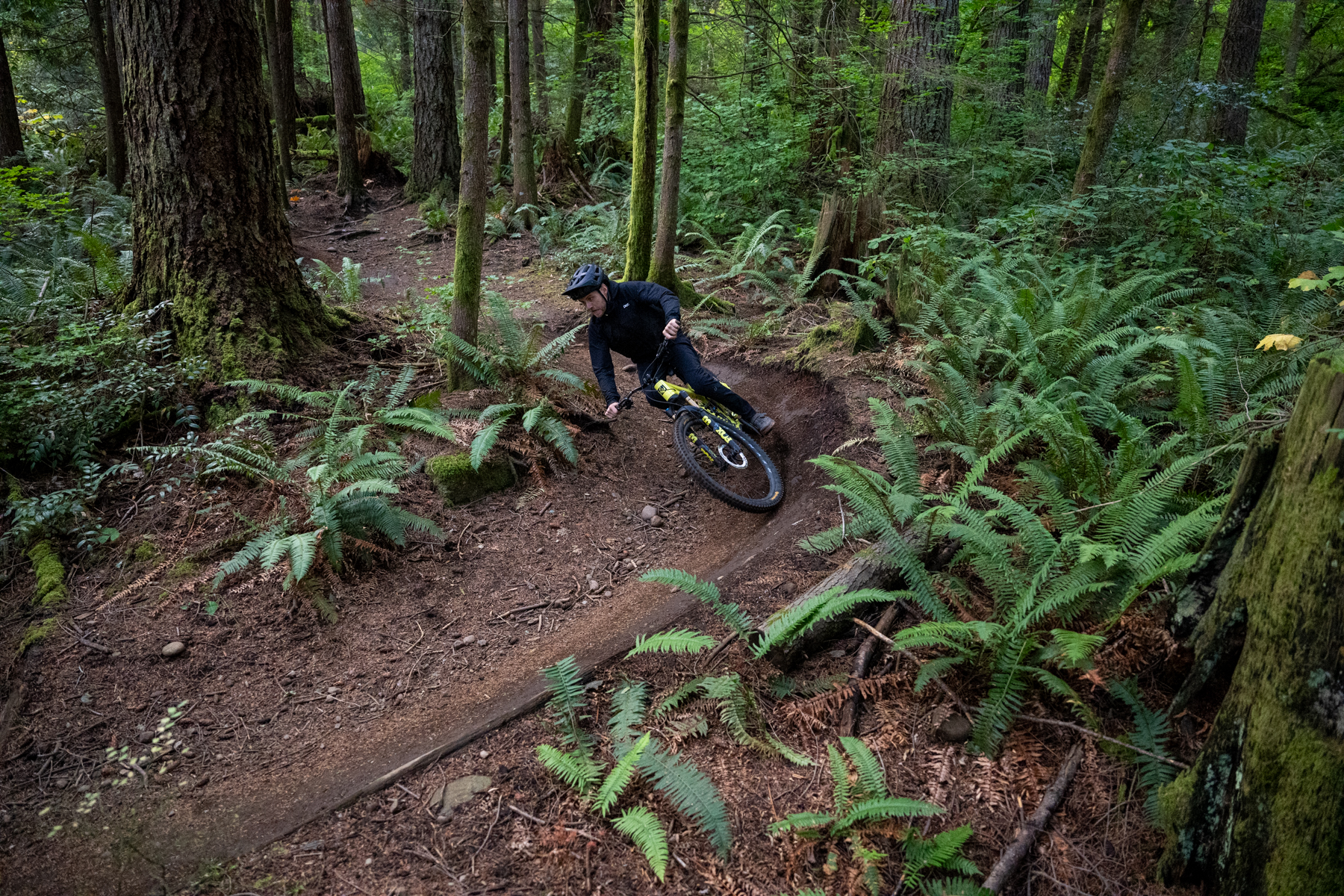
I didn’t second-guess that decision at all. I probably could ride a Medium Firebird if I really wanted to prioritize making it more nimble / quicker handling, and definitely have no interest in going up to the XL. But I got along well with the handling / overall level of stability of the Large frame, and also suspect that I’d find the effective top tube of the Medium to be a bit more cramped than would be ideal.
I had an easy time getting comfortable on the Large Firebird and didn’t need to swap in a different rise bar or anything else to get there. (I did end up swapping the bar for other reasons, as we’ll get to in a bit, but the stock setup worked nicely fit-wise once it was trimmed down to my typical 770 mm width.)
As I suspected, given their generally similar numbers, the fit of the Firebird V5 isn’t much of a departure from that of its predecessor. The new bike gets a slightly higher stack (in my case, this just made it easier to get the bars where I wanted them) and a fractionally shorter reach and effective top tube; these mostly serve to cancel out the sizing differences that arise from the increased stack height. The end result feels very similar.
Climbing
The Firebird’s climbing manners are nicely sorted out for a modern Enduro bike. It doesn’t stand out for doing any one particular thing especially well; rather, it just feels well-rounded and easy to get along with, provided that you’ve got realistic expectations for what a bike with 160+ mm of travel is apt to feel like on the way up.
The Firebird’s pedaling efficiency is solid, but not class-leading; it balances that with fairly good traction under power (which most bikes that are notably more efficient can’t match). The Firebird’s pedaling position has also been comfortable and easy to live with. Its seat tube is steep enough to make it easy to keep the front wheel planted on very steep climbs without being so upright as to feel like a winch-and-plummet machine only suited to really steep terrain.
The Firebird is also an above-average technical climber, as far as 160+mm-travel Enduro bikes go. Of course, there are any number of shorter-travel Trail / All-Mountain bikes that are easier to manage in tight, ledgy climbing scenarios — those just aren’t a strong suit of Enduro bikes in general — but the Firebird fares pretty well for what it is. The Firebird’s low-speed handling is a touch quicker than average for the class; its suspension is supportive and resists squatting deep into its travel under rearward weight transfers effectively; and its not-super-low bottom bracket doesn’t hurt, either.
That’s more true of the Firebird configured as a 29er than it is in the MX setup. Below, we’ll get into the finer details of how changing the rear wheel size impacts the handling of the Firebird, but at climbing speeds, the lower, slacker MX configuration feels a little more sluggish in its handling and gives up some of the responsiveness that the 29er configuration offers. The Firebird still climbs fine in the MX configuration, but its prowess in tight, techy bits is diminished somewhat.
Descending
The prior-generation Firebird felt like a notably focused, go-fast race bike within the market landscape that existed when we reviewed it a few years back. That’s also true of the new one — with an asterisk.
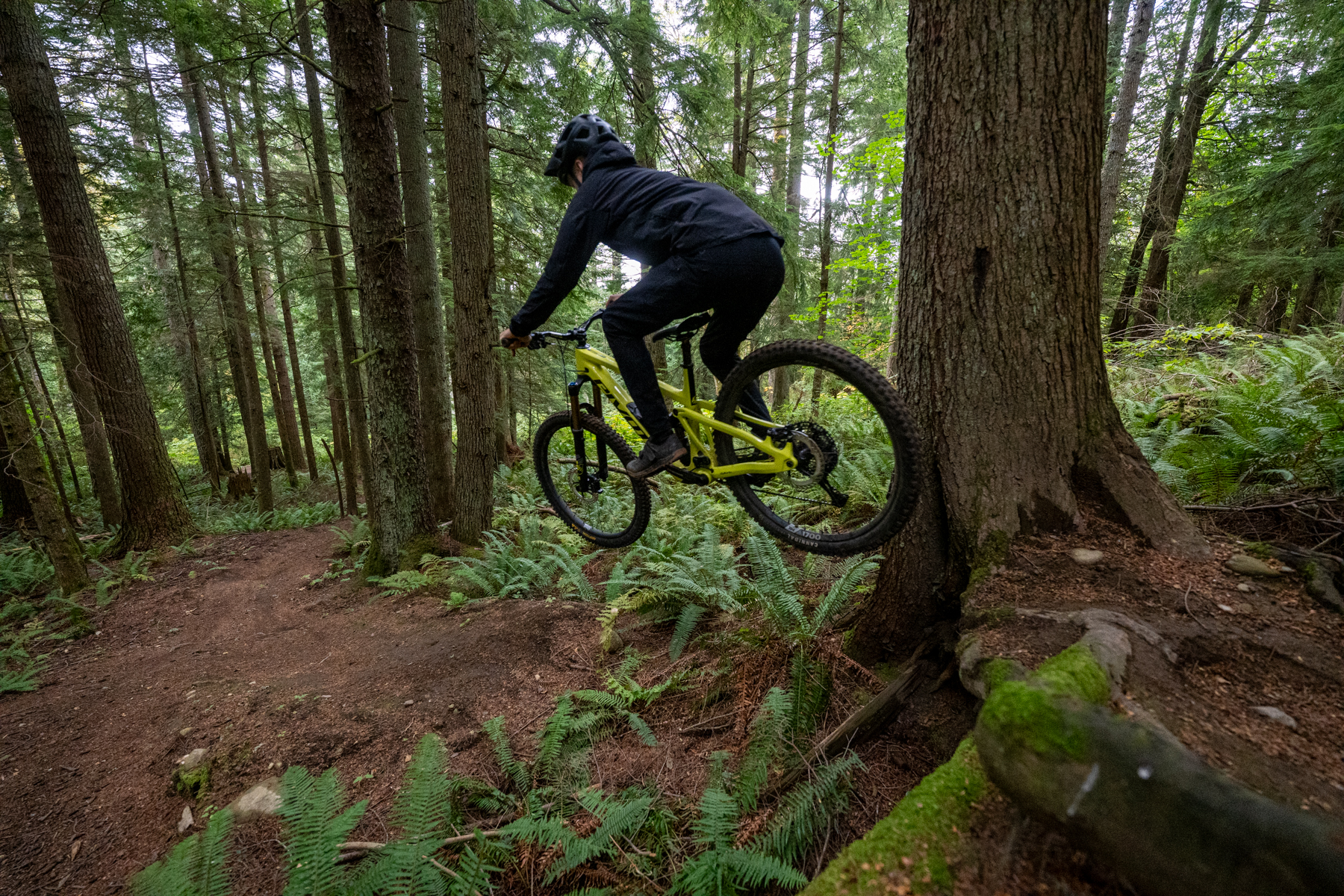
First, it’s worth digging into what I mean by that description. The Firebird is not some wildly aggressive, ultra-long-and-slack bike that needs to be pointed down a wide-open, steep trail to come into its own. It’s still pretty stable and composed at speed, but it’s a notch quicker-handling and more nimble in tighter spots / at lower speeds than a lot of other bikes in its class (especially in the Firebird’s 29er configuration).
That’s a really good recipe for an Enduro race bike. Enduro race courses (both at the EDR level and of the local amateur variety) aren’t generally wide-open gnar from top to bottom. The Firebird is a little more nimble in tighter, jankier bits than most bikes that offer similar composure when things get steeper, faster, and rougher.
That also helps make the Firebird a touch more versatile as a do-it-all All-Mountain bike compared to a lot of other 160+mm-travel Enduro ones. That said, I’m not inclined to recommend it to many people who would otherwise be looking at shorter-travel options. The Firebird still needs a bit of speed and pitch to feel like the right tool for the job, and it isn’t all that engaging on trails that are consistently rolling / lack sustained steep-ish bits. Rather, the Firebird feels like a modern Enduro bike first and foremost, just one that’s a little more nimble at lower speeds than average for the class.
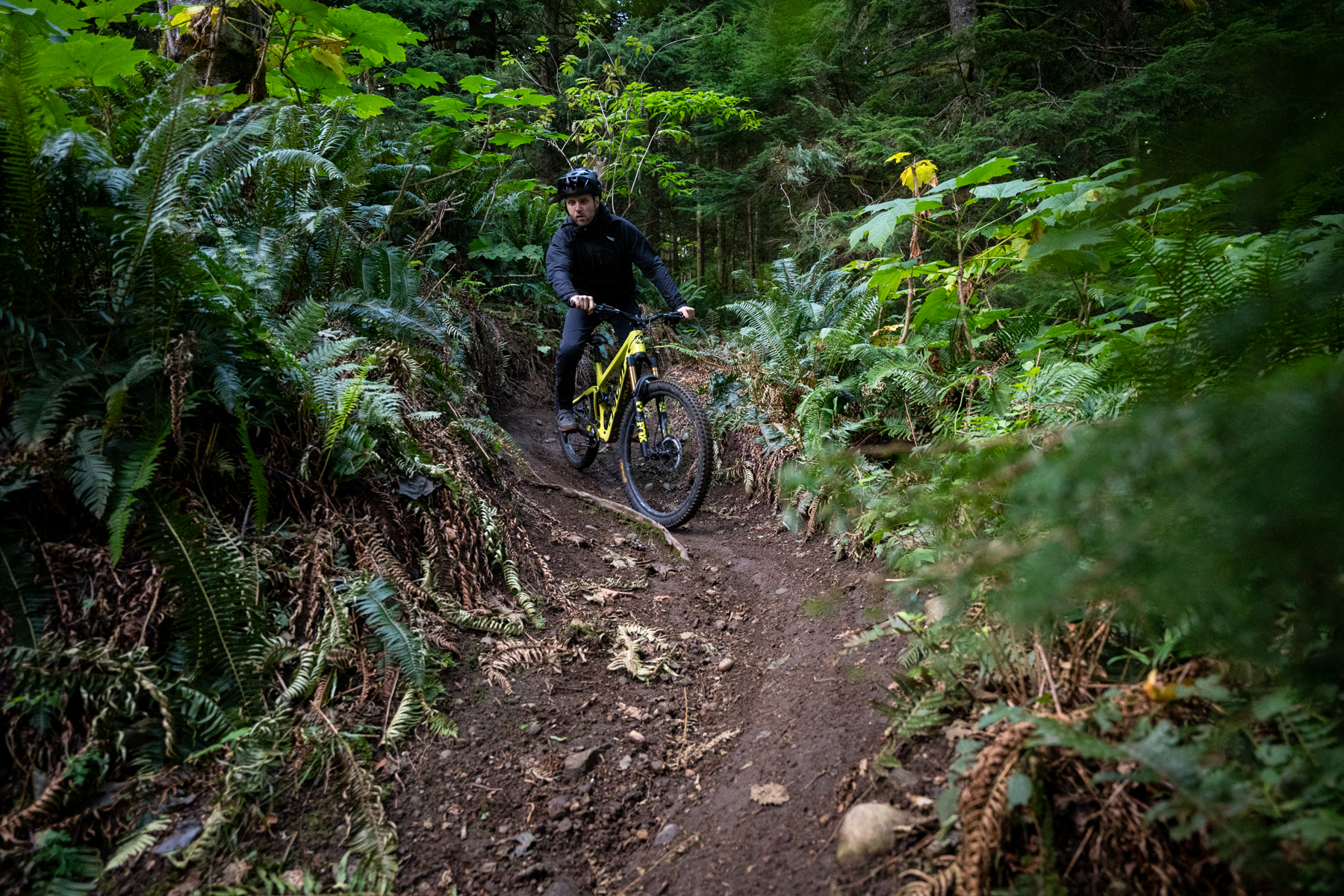
The Firebird’s suspension performance feels very well-rounded and aptly suited to its overall intentions. It’s neither ultra-planted and composed, nor exceptionally lively and energetic, but it strikes a more middle-of-the-road balance of the two.
The new progression flip chip at the lower shock mount also offers a useful range of adjustability. The less progressive setting feels a touch more supportive and lively, and the more progressive one makes the rear end feel slightly more planted and grippy. The difference is appreciable, but not massive. Either way, the Firebird is relatively supportive and responsive in how it builds speed by pumping, without feeling like it’s making big sacrifices in sensitivity and grip to get there. There are better options if you want a bike that specifically excels at bulldozing whatever’s in front of it, but those options are generally less lively and energetic than the Firebird, and its composure at high speeds in rough terrain is still quite good.
One of the prior-generation Firebird’s most notable traits was just how quick it could change direction once you got it up to a little bit of speed, particularly for a bike that was still relatively stable in its handling overall. I chalked a lot of that up to its relatively high bottom bracket, which helped make it quicker to stand back up out of leaned corners, but also hampered its ability to really load up the bike through the pedals and rail around a well-supported corner at times.
Pivot dropped the bottom bracket on the new bike a bit, and while it’s still not that low in the grand scheme of things, I like where they ended up. The new bike still delivers a lot of the quickness of its predecessor, but the tradeoffs feel tamped down substantially, and the latest Firebird’s geometry-adjusting flip chip feels a lot more usable in the 29er setting for me. I still preferred the Low setting overall, but the High one doesn’t feel like as much of an outlier in terms of its resulting geometry. I can readily imagine folks who specifically liked the prior-generation bike for that nimbleness (even in the Low setting) preferring the High setting on the new bike.
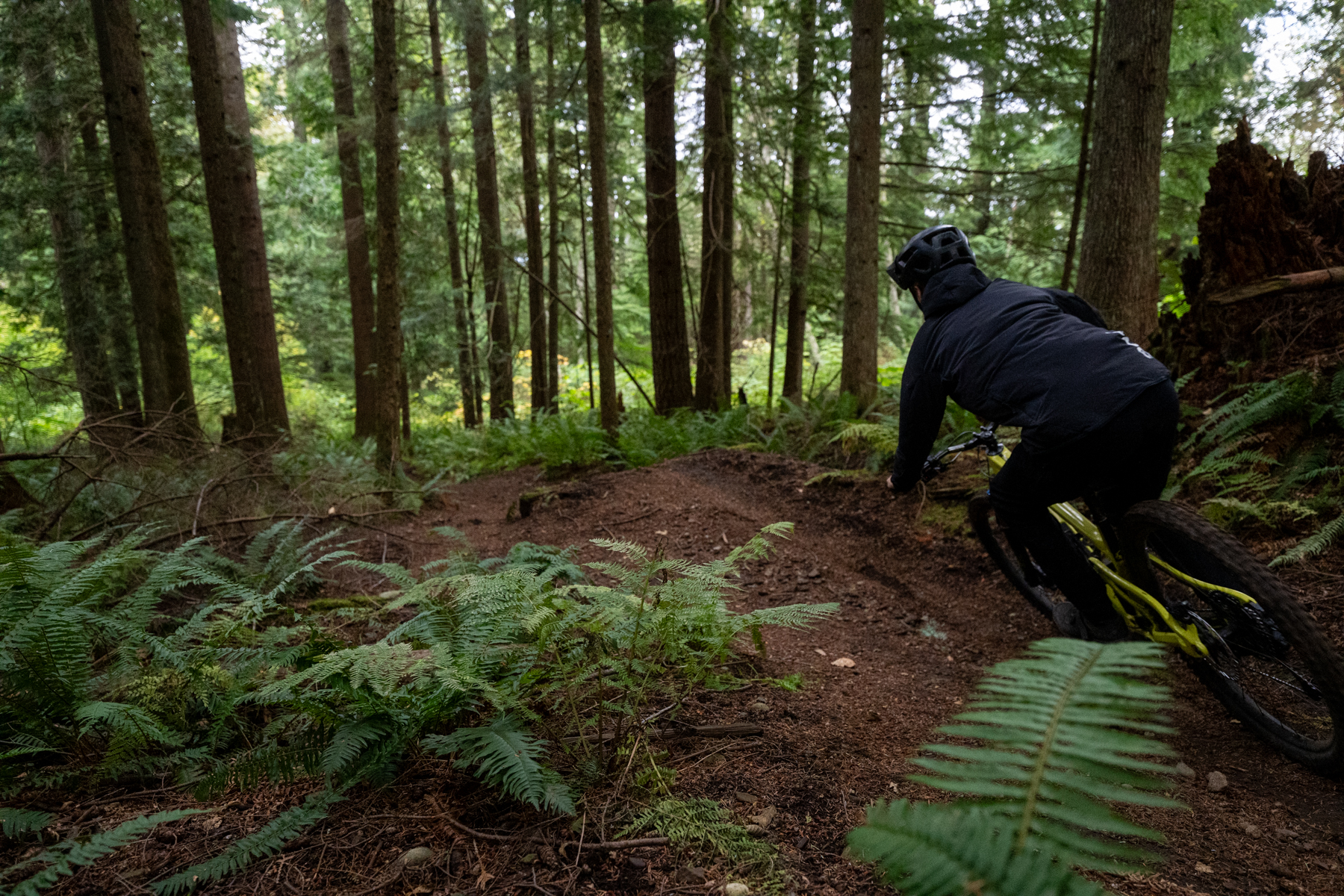
The Firebird’s chainstay length adjustment doesn’t make massive changes to the bike’s handling or overall stability, but it offers enough range to make an appreciable difference to its preferred body positioning and weight distribution. The longer setting is, as expected, a touch more stable than the short one, but the more notable difference is that the Firebird’s preferred body positioning shifts forward a notch in the shorter setting. Especially in the Long / 29er configuration, the Firebird feels fairly neutral and adaptable in its preferred stance; going to shorter chainstays and/or a 27.5’’ rear wheel shifts that preferred rider weight bias forward somewhat. And speaking of the MX option:
Wheel Size Options
The Firebird displays a notable change in its character — more so than many other convertible bikes — when toggling between 29’’ and mixed-wheel setups.
I’d chalk that up largely to the fact that the Firebird’s geometry changes substantially when making the swap. Bikes that handle a wheel-size swap via a flip chip or swappable shock mount usually end up with shorter chainstays in the mixed-wheel setting (and that’s true of the Firebird, too). Still, the Firebird also gets lower and slacker with a 27.5’’ rear wheel, even when comparing the MX / High setting to the 29’’ / Low one.
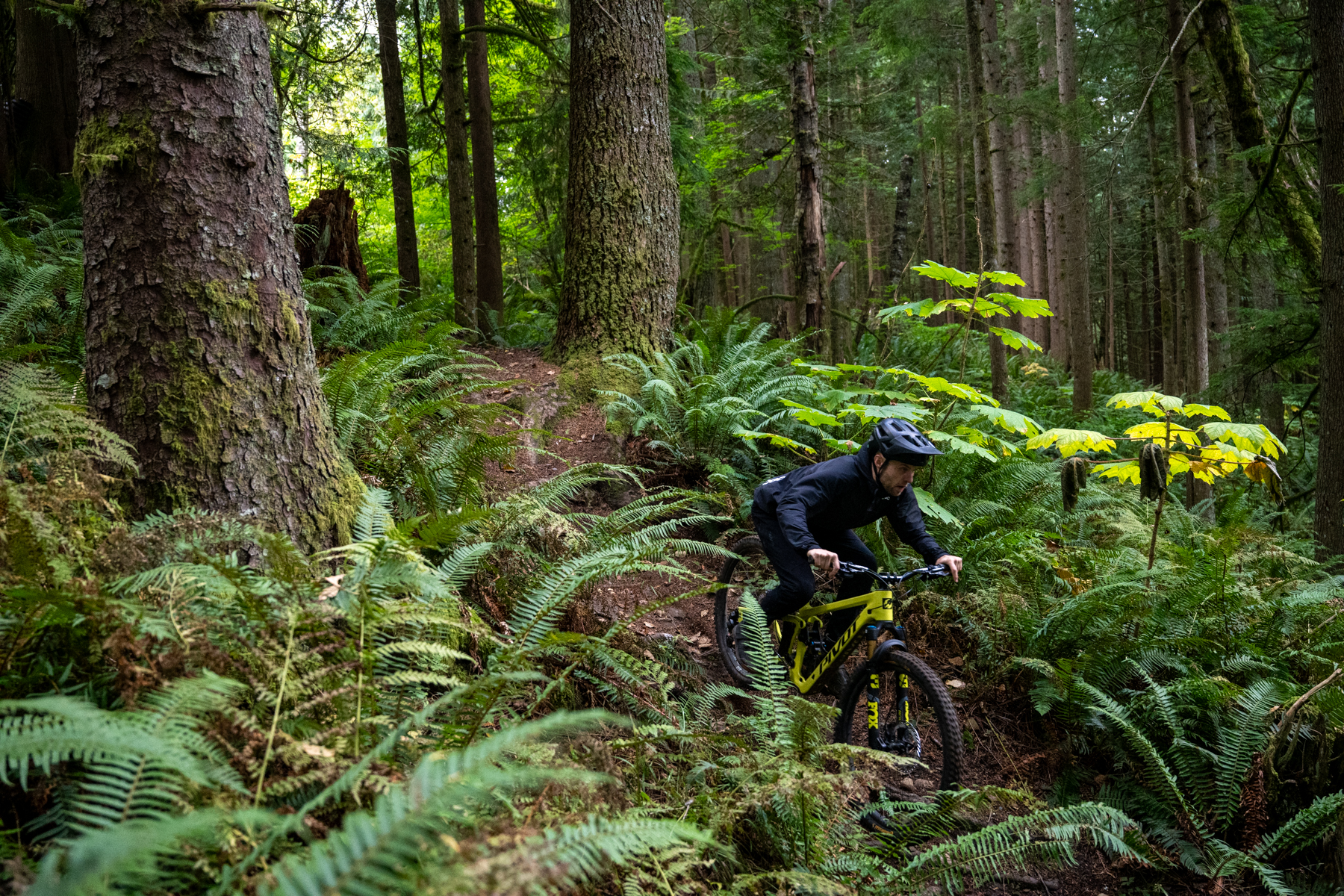
(Quick Aside on Additional Options: Pivot lists a geometry chart for the MX / Low combination, too, but I found that combo to produce a headtube angle that felt too slack for everything else that’s going on with the Firebird’s geometry / handling. The resulting 63.1° headtube angle isn’t that out there on its own, but I find relatively slack bikes to feel more balanced when they also get pretty long chainstays and low bottom brackets, and the Firebird doesn’t really fit the bill there. There’s no reason you can’t run that combo if you want to, but I found it to require a more forward stance with a smaller sweet spot in terms of body positioning than I wanted, and it required a lot of small steering corrections through the bar, even in very steep terrain. From here on, when I refer to the MX wheel setting, I’m talking about the High geometry setting to go with it.)
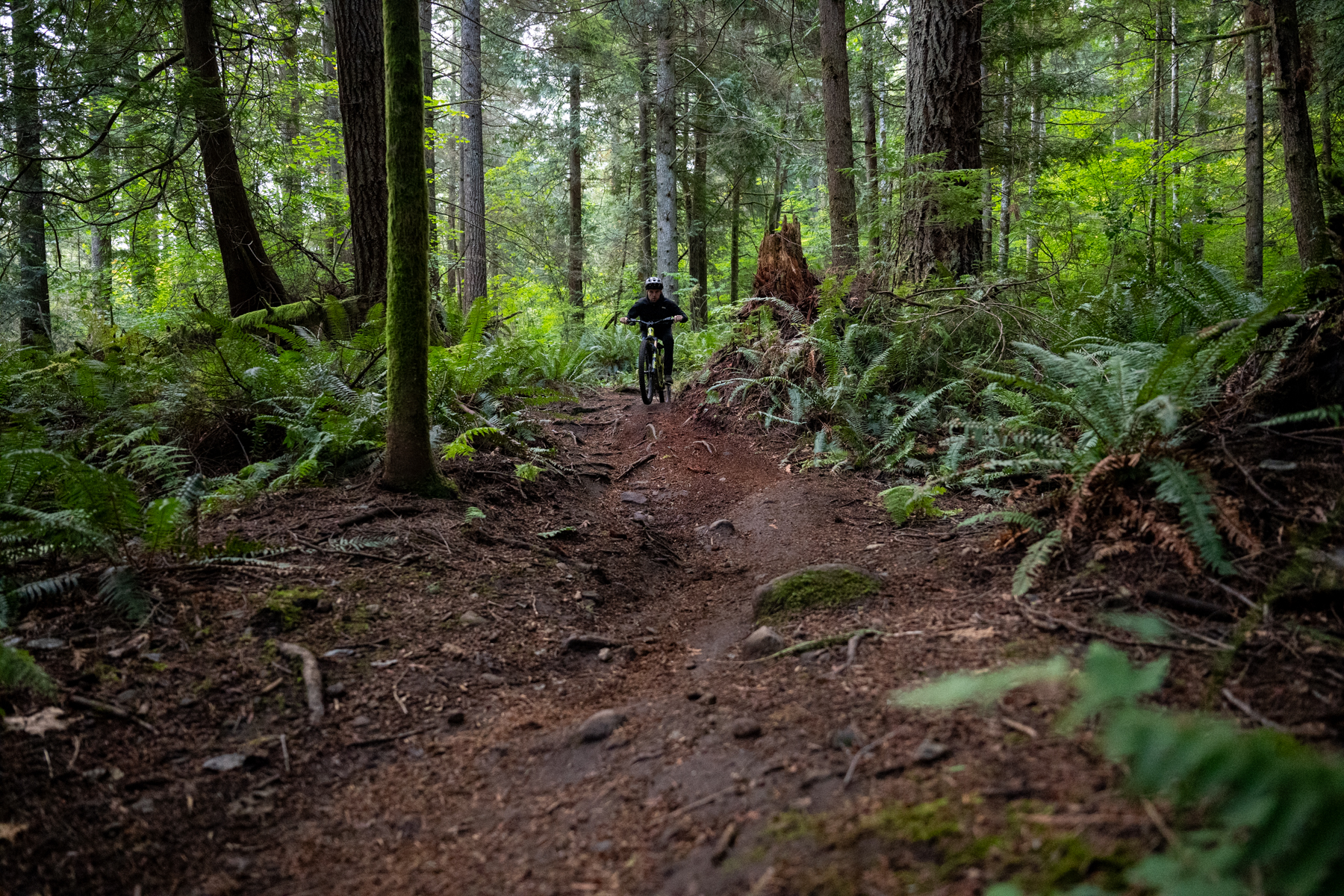
In the MX configuration, the Firebird feels substantially more playful and eager to slash the rear end around. It’s also a notch less sharp in its handling, generally feeling more easygoing / happier to be ridden less aggressively, but less precise and focused if you really want to charge.
To be honest, I wondered if the MX configuration on the Firebird was a bit of an afterthought when I first saw its geometry chart. Now having ridden it with both rear wheel sizes, I actually think what Pivot has done is pretty coherent.
Yes, the Firebird’s geometry and character change quite a bit with the wheel-size swap, and there probably will be some folks who’d prefer a theoretical combination of the sharper, more precise handling of the 29er setup with the added butt-to-tire clearance of the MX one. But Pivot has done a tidy job of making the Firebird convertible between two different end results: a precise, somewhat game-on Enduro race bike with sharp handling and a preference for being pushed pretty hard (as a 29er), and a substantially more forgiving, playful, freeride-oriented option (as a mixed-wheel / mullet setup).
The Build
The Firebird Pro XT Di2 build we tested is quite nice, though somewhat expensive for what you get, at $9,299.
The new Shimano XT Di2 group is excellent. That includes the brakes, which have continued to be entirely consistent in their performance and lever feel across a bunch of test pairs, in a welcome change from the wandering-bite-point-plagued prior models.
The DT XM1700 wheels are a reliable standby (though I’d rather see their beefier EX1700 siblings on an Enduro bike like this one), and the Fox 38 / Float X2 Factory suspension package performs quite well. Pivot did a nice job with the rear shock tune as well.
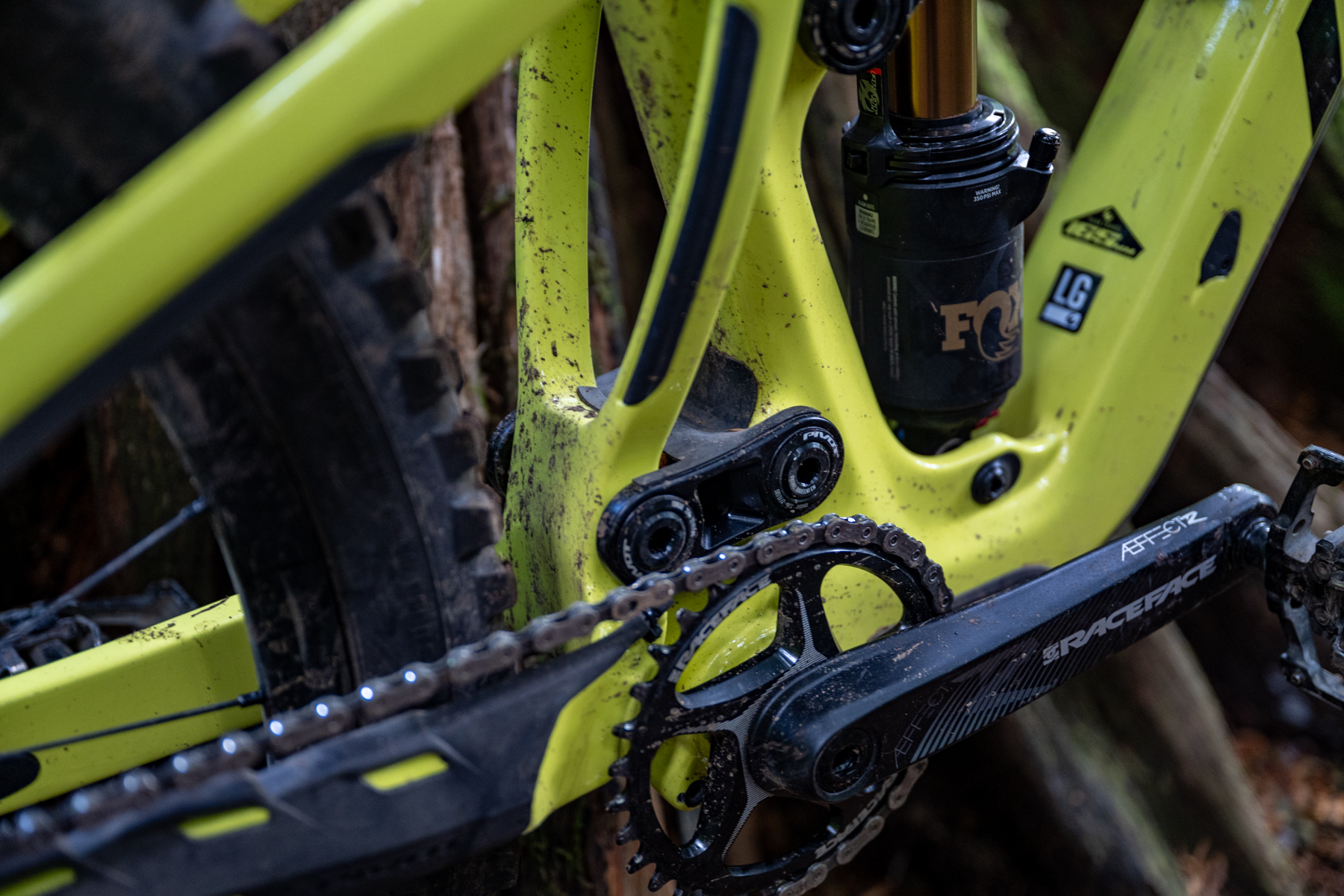
My couple of minor gripes were easily remedied, and they’re common complaints for me on a lot of other Enduro bikes. I’m a big fan of the Continental Kryptotal tires that come stock on the Firebird, but I found the Soft rubber front to feel pingy and undamped compared to my preferred Super Soft compound, and I punctured the rear Enduro-casing tire on my first ride. So, I swapped in a pair of DH-casing tires for most of the test period. To be fair to Pivot, the Enduro version of the Kryptotal is obviously the nominally correct option for a bike like the Firebird (if we take Continental’s naming scheme at its word), and the Super Soft Enduro version of the Kryptotal is new and hard to come by. Still, I wanted beefier, stickier tires to keep up with the Firebird’s descending capabilities.
I also found the stock Pivot-branded carbon handlebar to be notably stiff and somewhat harsh, so I opted to swap that out. While I was at it, I also swapped in some thinner-diameter grips (as is generally my preference). Finally, the stock upper chainguide is rather flimsy and didn’t survive an incident where the chain partially dislodged, got wedged in the guide, and I unwittingly tried to pedal through it before I realized what was going on.
On the plus side, the overall build quality and refinement of many of the frame details are very good. The new Firebird’s updated cable routing is tidy and much quieter than that of the prior-generation bike. The downtube storage hatch feels notably beefy and features one of the nicest latch mechanisms I’ve tried to date. And the new “Swinger” adjustable-length dropout is a clean and clever way to package chainstay length adjustability with a UDH derailleur hanger. It’s relatively easy to adjust, doesn’t require exchanging any parts, there aren’t any spare bits to keep track of, and it remained tight and quiet throughout my time on the Firebird.
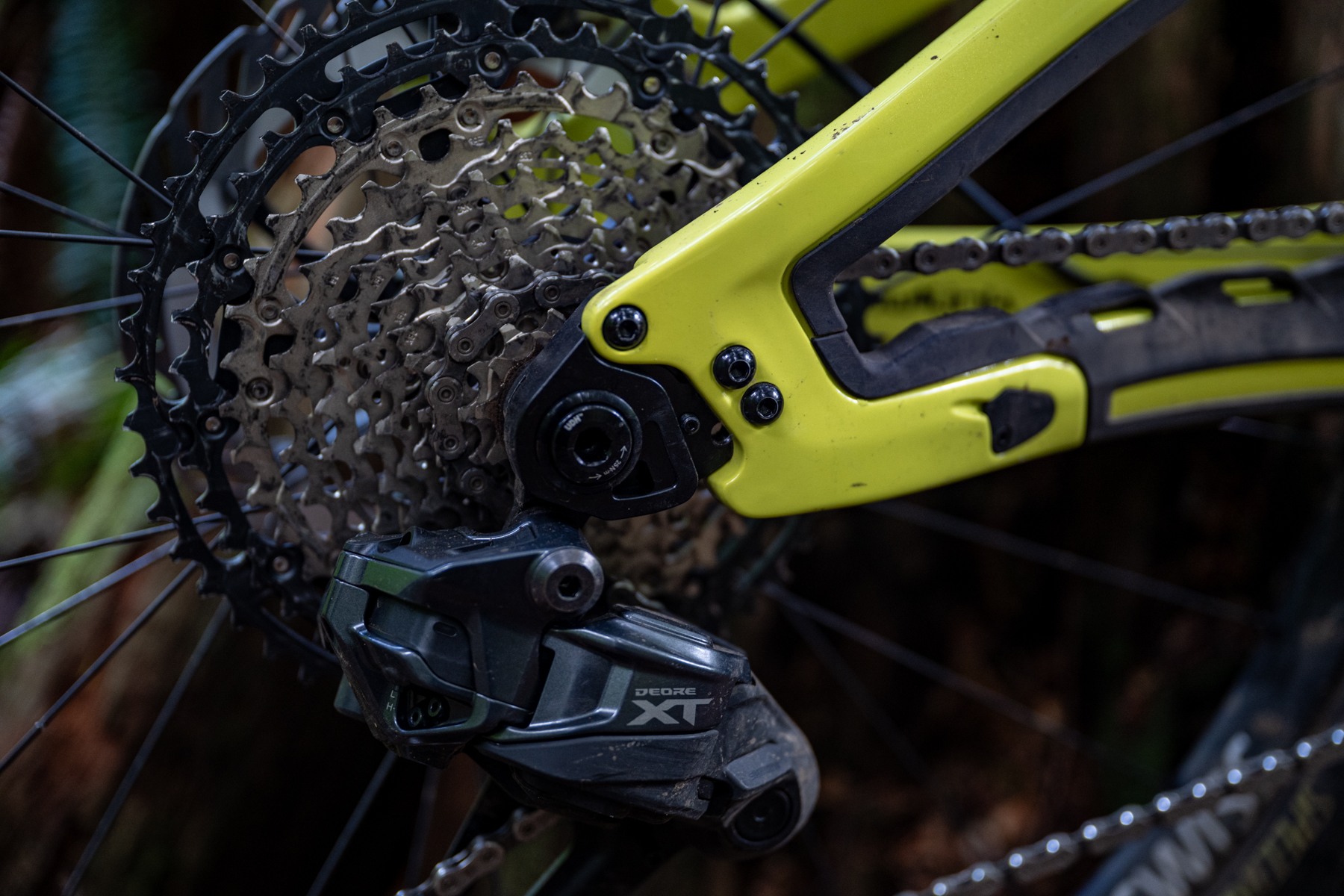
Who’s It For?
The latest iteration of the Firebird still feels like it’s meant to be a go-fast Enduro race bike first and foremost — and it’s a good one. But it’s also a lot more adjustable than the prior-generation version, and its character can be altered substantially depending on how you choose to set it up.
With a 27.5’’ rear wheel, the Firebird becomes substantially more playful and easygoing. While it gives up some of the sharp, precise handling that the 29er configuration offers, it’s a coherent-feeling package that’s likely to appeal to a bunch of folks who might find the 29er setup to feel more game-on and focused than they’d prefer.
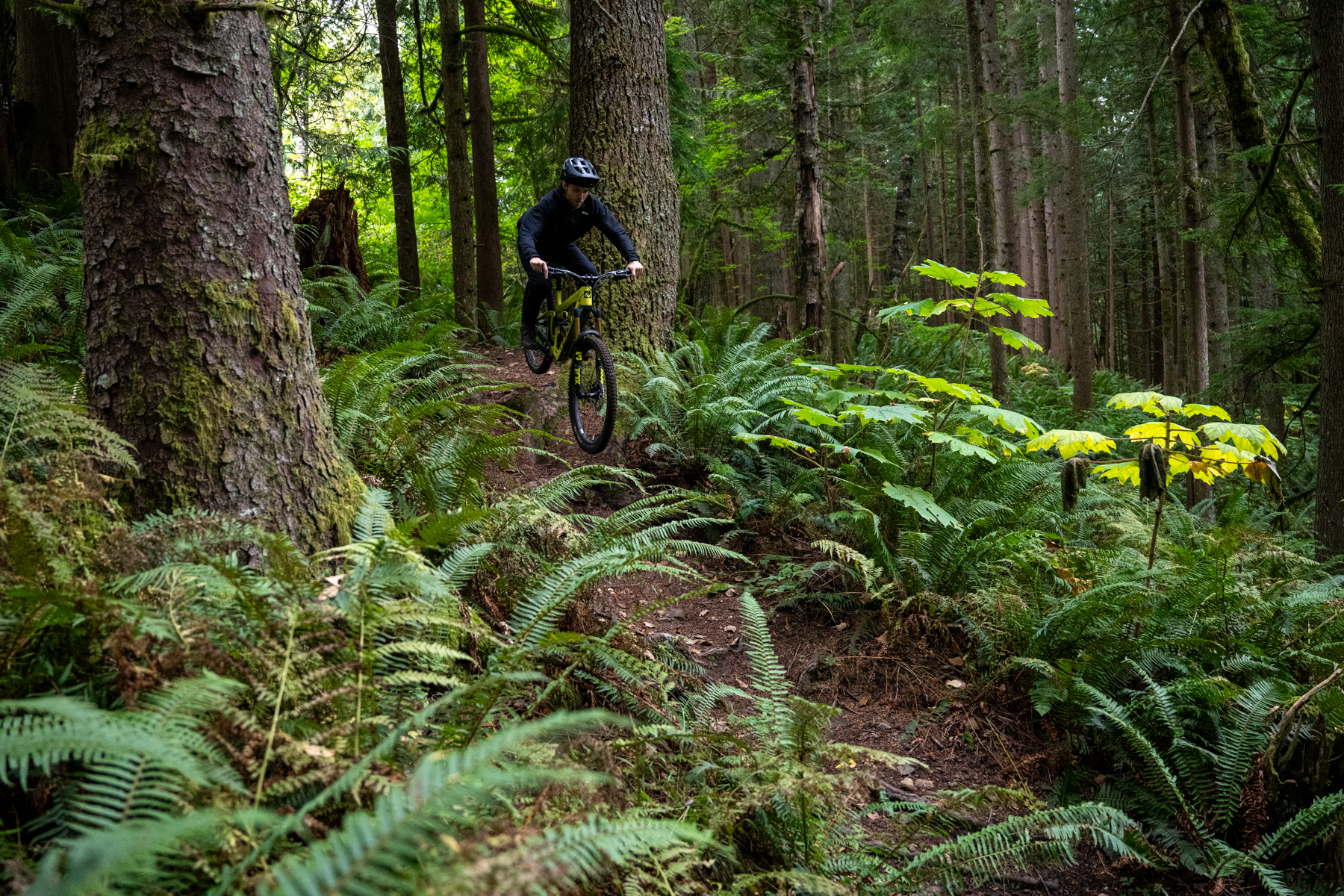
Bottom Line
Pivot’s latest iteration of the Firebird doesn’t stray too far from the prior-generation bike, but it feels like a better refined, more adaptable take on a similar recipe.
Similar to its predecessor, the latest Firebird is still a fairly stable, composed Enduro bike that’s a notch quicker-handling and more agile at lower speeds than most other bikes that offer similar stability. That said, the new Firebird is quieter, more adjustable, offers a more refined fit, and adds a few welcome features, including a particularly nice downtube storage compartment.
Mostly, it’s still a well-rounded take on a modern Enduro bike that stands out more for doing a lot of things well rather than trying to truly excel in one specific niche. As a result, it should appeal to a pretty wide swath of folks who want a bike this burly.
Deep Dive Comparisons
BLISTER+ members and those who purchase our Digital Access Pass can check out our Deep Dive comparisons linked below. Get our Digital Access Pass to view all our Deep Dives and Flash Reviews, or become a BLISTER+ member today to get access to that and a LOT more, including the best worldwide Outdoor Injury Insurance, exclusive deals and discounts on skis, personalized gear recommendations from us, and much more.
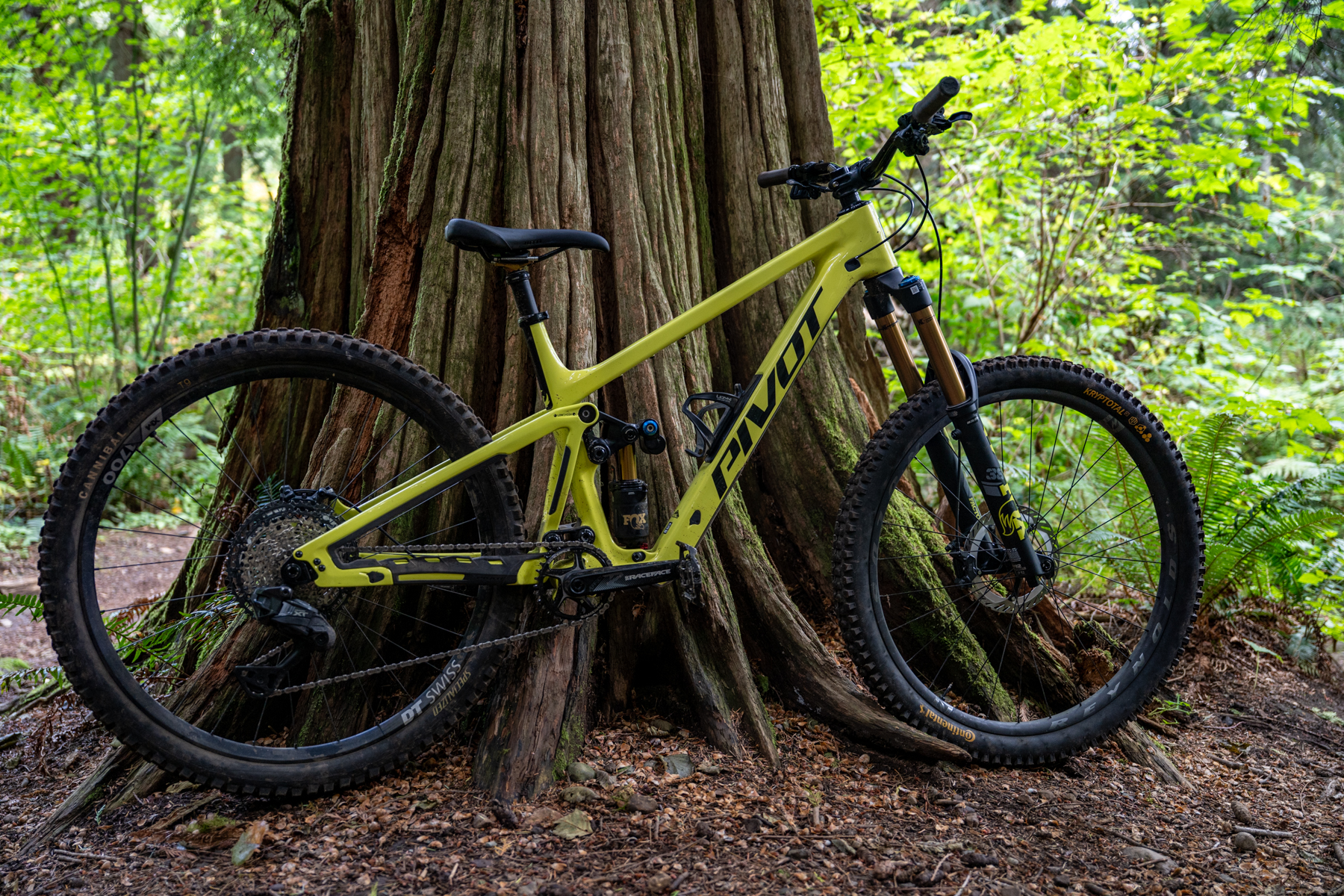
Deep Dive: Pivot Firebird V5
We compare the Pivot Firebird V5 to the Pivot Firebird V4, Yeti SB160, Yeti SB165, Rocky Mountain Altitude, Propain Tyee, Santa Cruz Megatower, Santa Cruz Nomad, and Ibis HD6.
Blister’s Flash Reviews and Deep Dives are accessible to those who purchase one of our paid subscriptions
To get our comprehensive Deep Dives and our initial, unfiltered reports on new gear, become a member and receive many other services, deals, and discounts.
If you’re already an active member, please log in.
(If you’re already logged in and a member in good standing and seeing this message in error, please refresh this page in your browser.)

Not really sure who their target market is given the fact that the base model starts at a whopping almost $7K and comes with the very base model SRAM components – the fact that SRAM 70 is anywhere on a bike this price is laughable. Pivot has obviously decided they are the luxury car of bicycles, however a 165/170 bike is pretty big for your average rider and I’m not sure who would be shelling out this kind of dough for that bike.